|
Introduction-Premise
◆Explanatory note: COVID-19 Risk Assessment Index
The purpose of this study is to identify the case-fatality rate (CFR:deaths/infected people) in countries, regions, and economic groupsaround the world.
In this paper, a comprehensive assessment of the case fatality ratio (CFR),
as a representative indicator of the risk posed by COVID-19 infection,
was conducted. It is not only the number of infected people and deaths,
but also the background to the deaths of infected people in the country
and region, specifically the number of hospitals, hospitalbeds, medical
facilities, doctors and nurses and the sufficiency of medical resources
to cope with a pandemic such as this one, as well as the presence or absence
of a medical system, and the extent to which these resources are available.
In addition, we considered the index to reflect the appropriateness of
national and local risk management policies and how to reduce the number
of deaths and avoid a medical collapse.
It should be noted that for a CFR of 10%, for every 100 infected patients,
10 deaths would result; for a CFR of 5%, for every 100 infected patients,
5 deaths would result.
As a result, it is becoming possible to make international comparisons
of the "country risks to health care" posed by COVID-19 that
were not previously known.
The following is an explanation of what the fatality rate is.
A similar indicator of CFR is the mortality rate, and the difference between
the fatality rate and the mortality rate is as follows. When the denominator
is the number of cases, it is the fatality rate, and when the denominator
is the population, it is the mortality rate. Here we are analyzing case-fatality
rates because we are looking at people infected with COVID-19 in different
countries around the world.
Difference between CFR , Survival Rate, Mortality rate
CFR= Number of Deaths/Number of Infected People
(confirmed cases)
Survival Rate = 1 - Fatality rate
Mortality Rate = Number of Deaths/Population
<Glossary>
In epidemiology, the case fatality rate (CFR) is the percentage of the
population affected by a particular disease that dies as a result of the
infection, and the fatality rate is usually expressed as a percentage and
represents a measure of risk.
In English, the fatality rate is called the Case Fatality Ratio, abbreviated
CFR.A fatality rate of 10% means that one in 10 infected people will die,
and a fatality rate of 5% means that one in 20 people will die.
The CFR can be used for a variety of purposes, but an increase in the CFR is generally a warning of an increase in deaths.
The CFR (Critical Fatality Rate) is an indicator that can be regarded as
a comprehensive index of important aspects leading to nosocomial infections
and medical disruptions, such as emergency transport (network), emergency
medical care, number of hospital beds, hospital risk management system,
number of physicians and nurses, treatment of pre-existing conditions and
chronic illnesses, and treatment of the elderly in each country.
We have been monitoring the CFR (number of deaths/infected cases) from
the new coronavirus (Covid-19) in major countries around the world almost
every three weeks since 15 May, but in Japan, cases of infection with the
COVID-19 do not lead to death immediately, but rather often occur after
a time lag of about three weeks, when the disease becomes more serious
and die.
The figure 1 below shows the number of infected people (cases) and the
number of deaths in Japan. Although the days (the period) of the time lag
to death can vary, there can be almost 3-week gap in each peak.
However, this time lag of 3 weeks is just the proof of analyzed cases in
Japan and cannot be applied to other countries as it is. This time lag
is estimated to vary depending on the percentage of elderly people, the
percentage of critical patients, the percentage of pre-existing diseases,
and the actual medical conditions (number of beds, number of medical staff,
equipment, technology, sufficiency of ICU, use of symptomatic drugs, etc.)
.
As for the duration of the time lag, its length is likely to vary depending on when the assessment is made. This is because the time from infection to death may have changed between the early days of the spread of infection, as it was raging in China and Italy (from late 2019 to April 2020), and July-August, when the epidemic spread around the
world after six months had passed.
However, since detailed data for countries other than Japan are not currently
available, this study tries to fit a three-week time lag to all countries
and groups in the existing CFR survey.
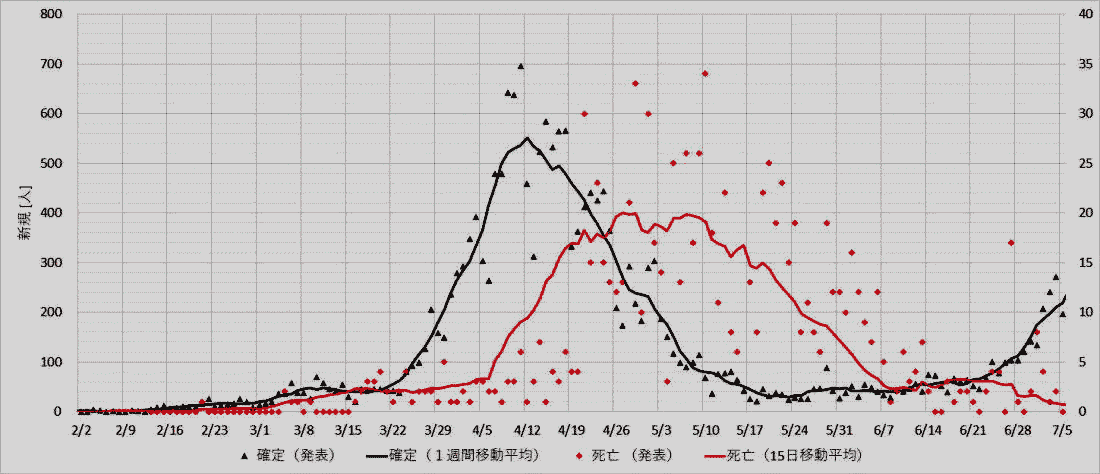
igure 1 Time Series Graph of Infections cases and Deaths in Japan
Legend ▲Date of Infection confirmed Solid black line 7 days moving average
◆Date of death confirmed Solid red line 7 days moving average "
Vertical Axis Left : Newly confirmed number of cases Right: Number
of deaths
Source:Analysis and graphing by Atsushi Takatori, Director of Environmental
Research Institute, Tokyo JAPAN
|
The following is a graph of the number of COVID-19 cases and deaths per
day in Japan published in the Mainichi Shimbun on November 22, 2020.
Reference: Number of COVID-19 cases and deaths per day in Japan

Source: The Mainichi Shimbun(Press), Jappan, November 22, 2020
Therefore, we re-calculated the CFR for the countries in the preceding
CFR study, assuming a time lag of approximately 3 weeks between infection
and death.
Note:The seventh case-fatality rate (CFR) risk assessment of the first
six surveys based on the cumulative infections and deaths has been included
in this report.
◆ Date and time of survey
The date and time of data acquisition in this study is 18 November 2020, UTC 4:27 am (1:27 pm Japan time). Original data source is Johns Hopkins University & Medicine, Coronavirus Resource Center.
https://coronavirus.jhu.edu/map.html
◆ Red line (horizontal line in the graphs)
The red line is the average CFR value as of November 18 of the 105 selected
countries covered by this survey.
Note that from the last survey (The 5th Analysis of CFR) onwards, the average
of the 3-week time lag analysis is indicated in the graphs that shows the
trend of time lag CFRs for each group rather than the cumulative average.
The cumulative CFR average value on November 18 decreased slightly from
2.6% to 2.4%, and the CFR average value considering the time lag increased
significantly from 2.4% to 6.2%.
◆ Outstanding trends and facts found by the Tenth Survey
<Changes in CFR depending on the cumulative number of confirmed cases
and the number of deaths>
As shown below, the transition from May 15th to November 18th for about
6 months has been on a downward trend. In this survey, targeting 105 countries,
the cumulative CFR became 2.4% (previous 2.6%) which was a slight decrease.
However, after taking into account the 3 weeks time lag, the CFR rose significantly
to 6.2% (previous 2.4%).
The cumulative CFR is declining because the infection continues to spread
on a global scale. On the other hand, when considering the time lag, it
can be seen that there are countries and regions where medical resources
are becoming tight due to the surge of the second and third waves of Covid-19.
Approximately 6 months after the first survey, the number of infected
people (the confirmed cases) in the world has increased 12.4 times and
the number of deaths has increased 4.5 times. As the number of cases continues
to increase, the cumulative case fatality rate continues to decline, dropping
2.0 points during this period.
After the first wave of this spring (March to April) had settled around
June, each country resumed its economy toward the summer vacation, and
the mobility of people has increased, in addition to the looseness of mind
and fatigue as well as the deregulation of government control measures,
the second and third waves started from autumn to winter are becoming larger
than the first wave. Thus the increase of confirmed cases in each countries
and regions results in the decreasing of CFRs as a whole. In Europe and
the United States,tens of thousands to more than 180,000 newly infected
people are confirmed every day, causing social turmoil. People are anxious
about that the number of deaths may also increase.
By the way, regarding the top 10 countries with the highest number of
confirmed cases, the maximum number of newly infected people and the number
of deaths from the beginning of November to November 20 is as follows from
the data of Johns Hopkins University.
Brazil is crossing the mountain, but Western countries are in a critical
situation in terms of both the number of cases and the number of deaths.
★Table <Maximum number of infections and deaths from November 1-20
for the top 10 countries with the highest number of cases>

Source: Sth COVID-19 Risk Assessment by Country/Region/Group, using the
Case-Fatality Rate (CFR) Considering the Time Lag Between Onset and Death
After fighting COVID-19 for nearly a year from the end of last year, each
country has accumulated experience and knowledge not only in the medical
field but also in the general society. Therefore, in some countries, the
elderly have become relatively protected. On the other hand, the spread
of the disease to young people under the age of 50 has been rapid and widespread
worldwide.
As a result, it can be seen that corona fatigue (Covid-Fatigue) has spread
to society and countermeasures have been neglected. Under such circumstances,
WHO announced at the end of October that serious sequelae remained among
people infected with the new coronavirus and issued a warning. It warns
against the idea that there is no problem if the number of deaths is small
even if the infection spreads.
Although the development of vaccines has progressed in each country and
expectations are rising among people, it is still unknown how effective
they are as there are several issues to be solved such as the safety of
the vaccine, effectiveness against mutated viruses, and effectiveness for
differences in immunity between different races. It is necessary to steadily
implement measures to prevent the spread of infection in each region without
excessive expectations for vaccines. It will take certain time to be acquired
for all the population on this globe.
Control of infection is essential to restart the economy. This is because
an increase in the number of infected people will result in a tightening
of the medical field and will lead to another lockdown, which will severely
deplete the economy and society. Already, European countries are facing
such a difficult situation, and as the opposition to the government is
increasing, and social unrest and turmoil continue.
The question again is how humanity can take sensible measures to stop
the spread of the virus and win the fight against it, without making excuses
for the self-centeredness of the "fewer deaths, the better" mentality,
and what each individual can do to help ourselves and society.
(1) World Case-fatality rate (CFR)
The following is the transition of CFR based on the number of cases and
the number of deaths (the numbers are rounded off when the graph was acquired
on November 20, the survey date).
Infection trend graph of 190 countries and regions around the world Source:
Johns Hopkins University Covid-19 World Map The graph is as of November
20, 2020, JST 9:26 am
 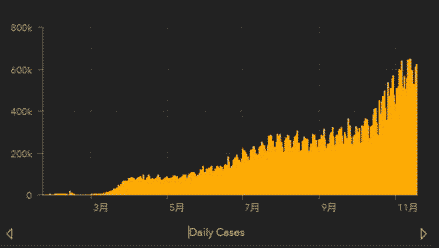
★1. Left: Trend of the cumulative number of Right:Trend of the daily
confirmed cases
infected people (confirmed cases) (Right end data:650,000 cases/day
on Nov.19, 2020)
(Totally 56,991,000 cases by Nov.19, 2020)
(Data is reflected until November 18, 2020 in this Report.)
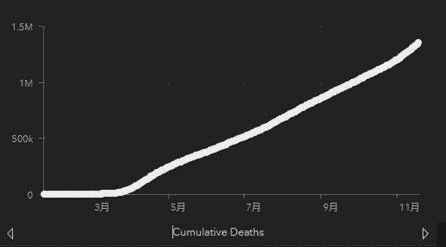 
★2. Left:Trend of the cumulative deaths Right:Trend of daily deaths
(Totally 1,362,000 deaths by Nov.19, 2020) (Rigth end data:11,000
deaths/day on Nov.19, 2020)
Looking at the trends in infections around the world as of November 18
from the above figure, both the number of cases and the number of deaths
are still increasing and no sign of downward trend, means no sign of convergence
of this pandemic.
It can be seen that the developed countries of the Northern Hemisphere,
the densely populated areas, tend to spread again toward winter.
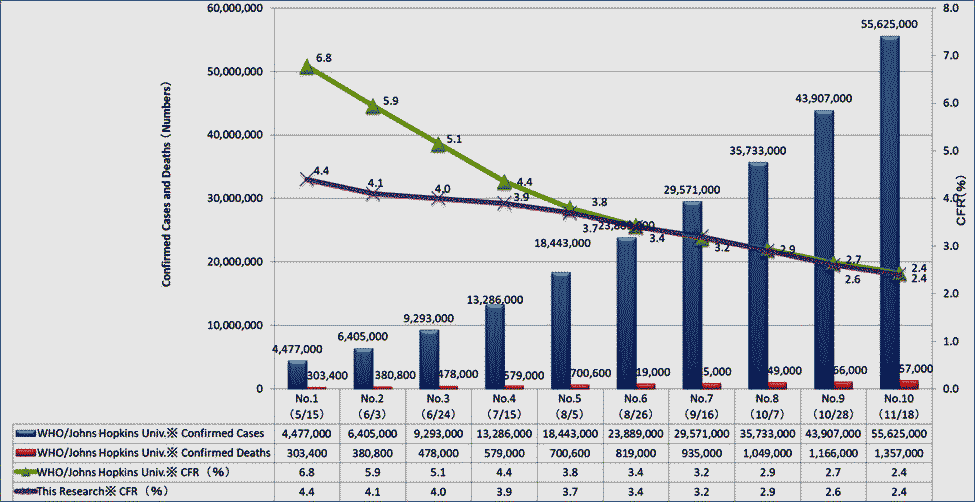
★Figure Trends in CFR(%) based on the number of cases and the number of
deaths
(numbers are rounded to the number of data acquisition time on each survey
day)
Source: Sth COVID-19 Risk Assessment by Country/Region/Group, using the
Case-Fatality Rate (CFR) Considering the Time Lag Between Onset and Death
Note:The number of countries / regions where infections have been
confirmed by WHO has increased to 189 in October and 190 in November.
Two new regions which have been added were the Solomon Islands and
the Marshall Islands.
The figure above shows the number of confirmed cases and deaths in 190
countries and regions (including cruise ships) around the world compiled
by WHO and Johns Hopkins University, as well as CFR based on the cumulative
data as of the survey date of this research. The CFRs of 105 countries
covered by this survey are shown in a line graph at the same time. In May,
there was a difference of about 2.4 points between CFRs in 188 countries
/ regions and 105 selected countries, but it gradually narrowed, and the
case fatality rate has been almost the same since the 5th survey on August
5. It seems that the differences between countries are becoming smaller.
★Table <Trends in CFR(%) by cumulative number of cases and deaths>

Source: Sth COVID-19 Risk Assessment by Country/Region/Group, using the
Case-Fatality Rate (CFR) Considering the Time Lag Between Onset and Death
<Cumulative CFRs of 105 target countries>
The change in the three-weekly CFR survey of 105 countries around the
world, shown in the table above, shows a drop of about 2.0 points from
4.4% on 15 May to 2.6% in late October.
In Canada, due to the significant spread of the disease in the eastern
metropolis of Toronto, the government has decided to impose a 28-day lockdown
in the city of Toronto from November 23. Over the last seven days, the number
of new infections and deaths per day has skyrocketed, with an average daily
cases of infection about 4,800 and deaths of about 65.(Source: AFP 11/21)
During this period, the number of infected people increased about 12.4
times and the number of deaths increased about 4.5 times. In the Northern
Hemisphere, the number of cases(infected people) has increased significantly
from autumn to winter, resulting in a low CFR. However, since the breakdown
of infected people has shifted to the elderly, there is concern that the
number of deaths will increase in the future.
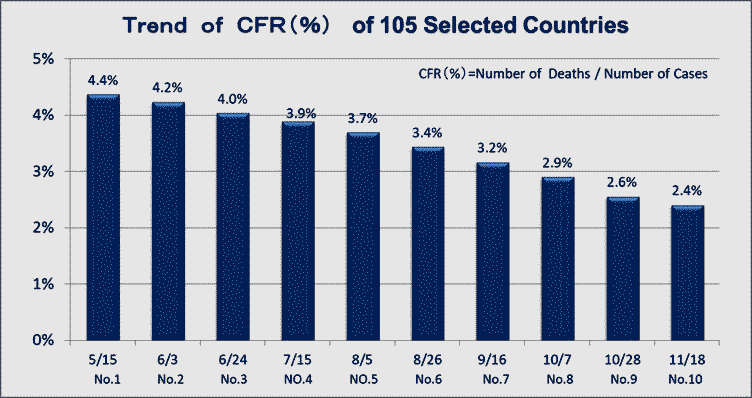
★Figure: Cumulative average CFR(%) for the 105 countries covered
Source: Tenth Comprehensive global COVID-19 risk assessment by
fatality rate with consideration of time lag in onset and death
(2) Case-fatality rate (CFR) by region and economic zone in the world
(2)-1 Trends in case-fatality rates(CFR) by region and economy by cumulative
number of deaths and cases(%), 10th Analysis
Note:This is the 10th report of the CFR survey without time lag, which
has been continued since the 1st survey.
・ As for the G7 and G20 countries, consisting of developed and less developed
countries, EU countries, ISN (Iceland, Switzerland and New Zealand), former
Socialist countries and Nordic countries, the CFR has continued its downward
trend since October. However, EU member states, ISN, ASEAN countries, former
socialist countries, and Nordic countries have fallen below the CFR of
2.4%, the Global average calculated on the the cumulative number of cases
and deaths. The developed countries of the G7 and G20 and countries of
Central and South America, Africa and the Middle East which include developing
countries are above the world average.
・ In the BRICS countries, the CFR has remained unchanged at 2.8% since
mid-July as the spread of the disease has not stopped except in China.
・ CFRs of ASEAN countries continued to decline from May to mid-July, but
have remained almost flat at around 1.5% since then.
・Since the number of cases are increasing in Central and South America,
the CFR has remained flat at around 3% since the beginning of June, and
no improvement has been seen.
・CFRs of African countries declined from May to June, but after that, they
fell by only 0.2 points and remained flat at around 2.6%.
・The CFRs of Middle East countries has been on the increase since June,
but has remained high at 3.7% since August 5.
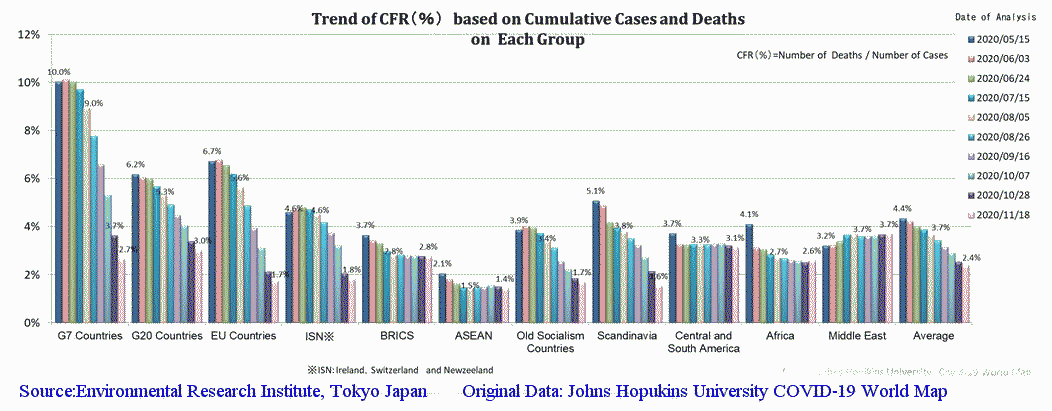
★10th Analysis: Trends of CFR(%) by Groups based on cumulative data
(2)-2 Trends in CFR(%) with a 3-week time lag : World
・Considering the time lag of 3 weeks, the global average gradually decreased
toward the end of August, but after that, the infection re-spread in various
places, and it remained around 2.4%. However, in November, it rose sharply
to 6.2%.
・A look at the change from October to November by group shows that while
most of the groups have seen relatively small changes, African countries
and the Middle East region have seen significant increases from 2.7 to
20.6 and 3.8 to 6.8, respectively.These two groups have pushed up the overall
average.
・In Africa, there was a significant increase in time lag CFR in Sudan.
During the three weeks from October 8th to 28th, 94 people have infected
the disease, while the number of people who died from the end of October
to November 18th was as high as 338, so the CFR was 360%. This is a factor
of this big surge in Africa.
・In the Middle East, the war-torn Yemen has seen the CFR rise to 6.2% with
8 deaths in three weeks, compared to 13 in the same period in Sudan, although
in smaller numbers. In these politically uncertain areas, the data itself
is uncertain and the actual situation may be more serious.
・ As Autumn is deepening, and the virus is becoming more active due to
dryness and lack of ventilation caused by the cold weather. Thus, the spread
of infection is conspicuous in European countries including Eastern Europe.
Compared to Western European countries like Italy, Spain, the United Kingdom,
and France, the infection progresses more slowly in Eastern Europe, reaching
a large peak from autumn to winter. This may be partly due to the weakness
of the economy compared to Western European countries, and partly due to
political and social unrest in the region,
such as Armenia vs. Azerbaijan.

★6th Analysis: Trends of CFRs(%) by Region with a 3-week time lag
(3) Case-fatality rate (CFR) by country in G7 members
(3)-1 Trends in CFR(%) by region and economic zone based on the cumulative
number of deaths and cases, 10th Analysis
Note: This is the 10th report of the CFR survey without time lag, which
has been continued since the 1st survey.
・The average CFR based on the cumulative data of G7 countries decreased
significantly from 10% to 2.7% during the 6 months from mid-May to mid-November.
The UK, Italy and Canada are above the G7 average of 2.7%. France (2.3%),
the United States (2.2%), Germany (1.6%), and Japan (1.6%) were below the
world average of 2.4%, with Japan maintaining low figures.
・ Italy and other European countries have been improving since late June
due to the rapid spread of infection, but after the economic resumption,
the number of cases have increased again from summer, and it is said to
be the third wave in autumn. The spread of infection continues. Social
turmoil is spreading as lockdown measures have to be taken again, especially
in metropolitan areas.
・ France had a high CFR of 20% in May, but has dropped significantly since
then, and by the end of November, six months later, it had fallen to 2.3%,
which is less than 1/8. However, due to the spread of infection from October,
more than 120,000 cases were confirmed in one day on November 8, and the
cumulative number of cases exceeded 2 million on November 14. It has risen
to 4th place in the world, and anxiety is spreading in society.
・ In the UK, after the first wave in April, the number of cases were small
and stable for a while, but in September it began to increase rapidly and
continued to expand in October and November. In October, the number of
infected people per day exceeds 20,000 several times, and the second wave
is larger than the first wave. The death toll has been kept low compared
to spring, but there are concerns that the medical system will be tight,
with 600 deaths on November 17.
・ The first wave of Italy, where the infection first spread in Europe,
peaked in March and the number of cases were up to 7,000 a day, but in
October, again the number of cases increased sharply and jumped six times
as much as the first waves of Spring time. And finally on November 17,
it exceeded 40,000 cases a day. In Italy, the infection has begun to
spread throughout Campania in the south, and there are concerns about its
spread in local cities. Cumulative CFR has dropped to 3.8% due to the spread
of the infection.
・ In Canada, the number of cases per day was the highest in the first wave
of spring, but in the second wave after October, it greatly exceeded spring,
and in November, more than 6,000 new cases per day are being confirmed.On
the other hand, the number of deaths has not increased as much as in spring,
so the cumulative CFR has dropped to 3.6%.
・ The number of confirmed cases in the United States increased by about
2.7 million in the three weeks from October 28 to November 18, reaching
the world's highest cumulative cases of 11.7 million. The death toll also
increased by 22,300 in three weeks to over 250,000. Especially since the
beginning of November, more than 100,000 new cases have been confirmed
every day, and on November 19, more than 187,000 people were infected.
As a result, cumulative CFR continues to decline, dropping to 2.2%. The
number of deaths peaked in the first wave in mid-April, with more than
2,600 deaths a day. Although it went down the mountain in mid-June, it
started to rise again and then started to rise from 1,000 deaths a day.
Hundreds of people continue to die. It is feared that the number of deaths
will increase among infected people from autumn to winter.
Looking at the positive rates by state in the United States, Hawaii is
as low as 2% along with Vermont, Maine, and New York in the east, while
in South Dakota, Iowa, Kansas, and Idaho, the positive rate is as high
as 40% to 50%. Thus, the entire United States is being swayed by the wave
of infection. Although the presidential election is over, the
ability of each Governor of the states is being challenged as the entire
country remains politically and socially divided, with no national leadership
in place. CFR fell to 2.2%, about one-third in the six months from May
to November, but if the infection spreads further during the holiday seasons
such as Thanksgiving and Christmas in the fall and winter, the CFR may
start to rise again.
・ Germany has achieved good results from the beginning among the G7 countries,
and survived the first wave of spring with excellent results, and the number
of cases and the number of deaths remained low in the summer. The maximum
number of infected people was about 7,000 a day. However, in October, the
infection spread rapidly, and the number of cases per day increased from
more than 7,000 to over 30,000 in early November. With the rapid increase
in cases, the number of deaths has reached the second wave. The second
wave of deaths peaked with a surge in the number of infected people, but
at its peak in early November, the number of deaths was kept relatively
low at over 300, compared to a daily death toll of over 500 in mid-April.
As a result, the CFR declined as the number of cases increased, dropping
to 1.6% on November 18.
・ In Japan, the number of cases exceeded the first wave in the second wave
in August and increased significantly, so the case fatality rate was less
than 2%, which is the best number in this group. However, it has improved
since then. It is possible to say that before the second wave is settled,
the increasing trend in autumn and winter becomes remarkable, and the number
of cases per day exceeds 2,000. In Japan, there are fewer tests than in
Europe and the United States, which means that the number of potentially
infected people might quite high, so there are deep concern that the number
of deaths is likely to rise in the future due to the spread of infection
in the home to the elderly.
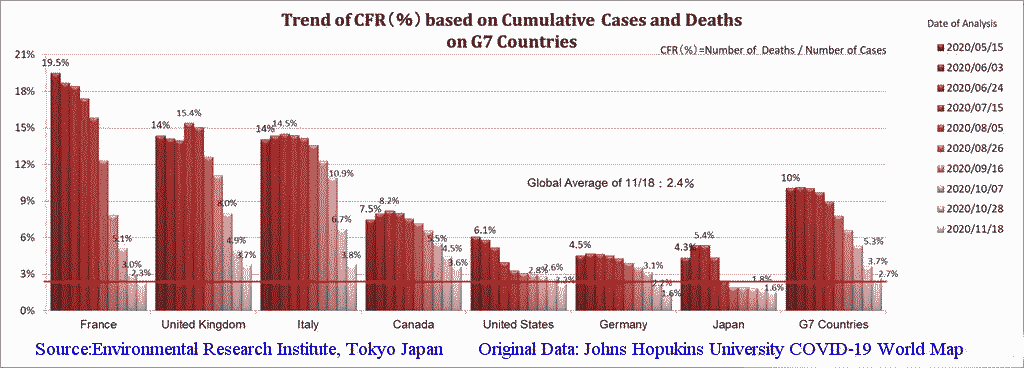
★10th Analysis: Trends of CFR(%) by G7 members based on cumulative data
The figure below shows the number of daily confirmed cases and deaths in
major countries of this group. The yellow graph on the left shows the number
of infected people, and the white graph on the right shows the number of
deaths. Please note that the horizontal axis is the elapsed date and the
vertical axis is the number of people, and the scale differs from country
to country. (Source: Johns Hopkins University, Covid-19 World Map)
The data of the number of cases and the number of deaths in the United States and France are shown below. The US had a high CFR in the first wave of spring, with higher wave of deaths (over 2,500 deaths/day) than that of infections. However, the number of deaths during the spread of infection after the summer has been continuing high around 1,000 to 2,000/day.
On the other hand, looking at France, the stable period has continued
for a long time since the first wave in March, but the second wave from
mid-September exceeded the first wave, and the number of deaths is increasing
rapidly.
 
★Trends in the number of cases and deaths in the United States
(cumulative infections: 11,350,143, cumulative deaths: 248,600)
 
★Trends in the number of cases and deaths in France
(cumulative infections: 2,036,755, cumulative deaths: 46,273)
Source: Johns Hopkins University Covid-19 World Map website
Note:Numerical values are November 18, 2020, when JHU data is
acquired, graphs are November 20, 2020, 9:26 am JST
(3)-2 Trends in CFR(%) with a 3-week time lag : G7
・ The G7 as a whole saw a high number of deaths in the first half of June,
with an average fatality rate of 9.2%, but then a significant drop, with
the lowest number of deaths in early September, four months later, resulting
in a CFR drop to 0.3%. After that, it started to rise slightly, and six
months later reached 2.1% in mid-November, the same level as in early August.
・ The increase in CFR is considered to be due to the spread of infection
in European countries, including Eastern Europe, the USA and Japan, which
started in the autumn and winter and that resulting increase in deaths.
Each country turned upward from the end of August to the end of October,
and Italy in particular rose significantly in October. Continuing from
the end of October, Italy has the highest case fatality rate of 3.7% in
the G7 members in this November survey as well.
・ In France, the second wave of infection spread in the summer, but the
case CFR dropped to 0.3% at the end of August. However, in the fall, the
infection spread rapidly, and the lockdown has returned to the whole country.
There is concern that the number of deaths will increase in the future
because it is reported that medical institutions are tight.
・ In the UK, the CFR dropped to 1.0% in late August and in Germany to 0.3%,
but the infection spread mainly in urban areas, and the case fatality rate
rose to 1.9 in November in both countries.
・ In Japan, considering the time lag, it has been flat since June and has
been in the range of 1.0% to 1.5%. Since, the number of infection among
elderly people is increasing, and the number of severe cases has gradually
increasing from the autumn, the CFR is likely to rise in this winter season.
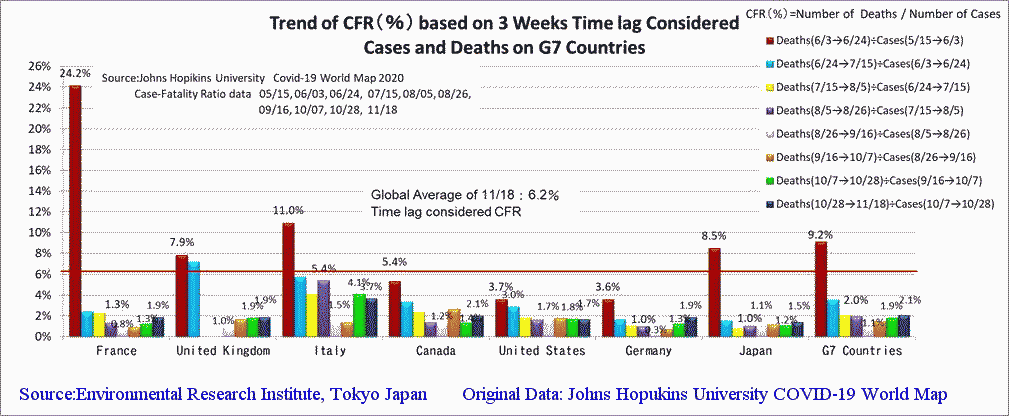
★6th Analysis: Trends of CFR(%) by G7 members with 3-week time lag
Below is a graph showing the daily changes in the number of cases and deaths
in major countries of G7.
(Sources are JHU, Covid-19 World Map)
The figures were obtained from JHU data on 18 November 2020. Graph is 9:26am
JST, 20 November 2020
 
★ Trends of the number of cases and deaths in the United Kingdom
(cumulative number of cases: 1,414,359, cumulative number of deaths:
52,839)
 
★Trends of the number of cases and deaths in Japan
(cumulative number of cases: 121,247 people, cumulative number of deaths:1,895
people)
(4) Case-fatality rate (CFR) by country in G20 members
(4)-1 Trends of CFR(%) by region and economic zone based on the cumulative
number of deaths and cases, 10th Analysis
Note:This is the 10th report of the CFR survey without time lag, which
has been continued since the 1st survey.
・ Looking at the average of G20 countries including middle-income countries,
the cumulative CFR value has halved from 6.2% to 3.0% in the last 6 months.
The average of the G7 in mid-November was 2.7%, but in the G20 countries
including the middle-income countries became 3.0%, which was slightly lower
than the average of G7 from 3.4% at the end of October.
・ Looking at all countries except the G7, even though Mexico has fallen
slightly, it still remains high at 9.8%, pushing up the average for the
G20 as a whole.
・ In Brazil, the mountain of infection spread that started in March peaked
in August and is slowly descending, but the infection has spread again,
and the curve seems to have flowed into the second wave as it is. The cumulative
number of cases has exceeded 5.98 million and is about to reach the 6 million
mark. The mountain of deaths also exceeded 1,000 people every day for a
long time from May to October. At the end of October, it seemed that it
had finally descended the first wave of mountains, but it has been hit
by the spread of infection and the increase in deaths again. As a result,
CFR is relatively low and remains around 3%.
・ In Indonesia (about 490,000 cases and about 16,000 deaths), the CFR has
been declining to 6.5-2.3% in the past 6 months, but the peak number of
cases is in September. Although it appeared in the middle of the month
and decreased once at the end of October, the infection has spread again
in November. The number of new cases per day increased bynearly 1,000 from
September and exceeded 5,000 on November 13.
・ Since China peaked before May, it has remained at around 5% during this
survey period.
・ In Argentina (about 1.35 million infected and about 37,000 dead), the
number of cases increased with a gradual upward trend, peaking at 18,326
on October 21st. Since then, the number of cases has gradually decreased.
The number of deaths lasted for a long time from 300 to 400 people / day,
but has been declining since mid-November. However, as many as 3,350 people
died on October 1st. The cause is not clear. Cumulative CFR has remained
between 2.5 and 3%.
・ In India (8.88 million infected and 130,000 dead), CFR has dropped to
1.5% and halved in the last five months, but the background is the explosive
increase in the number of cases. Already on the night of November 20, the
number reached 9 million. Both the number of cases and the number of deaths
slowly climbed a large mountain, peaking in mid-September, infecting less
than 10,000 people a day and killing more than 1,000 people/day. However,
after that, both infected cases and deaths are slowly declining. Therefore,
CFR is flat at around 1.5%.
・ Turkey's CFR (about 430,000 cases and about 12,000 dead) has remained
flat at 2.8-2.6% during this period. The first wave peaked in mid-April,
and the number of cases exceeded 5,000/day, but after that, the number
of cases surged again in November, exceeding 4,000/day. The number of deaths
peaked at more than 100 people a day in mid-April, but after that it declined
once, but it started to increase from mid-August and then started to rise
again in November without any sign of decreasing.
・ South Korea (30,000 infected and 500 deaths) has well controlled the
spread of infection from the beginning, and has remained flat at around
2%, and is in a stable state.
・ South Africa (760,000 infected and 21,000 deaths) peaked in the mountains
in mid-July and has been declining slowly since then, but since September,
around 1,000 cases confirmed a day and it continues. The death toll also
peaked in late July. Although it has decreased since then, there are many
days that more than 100 people die a day. As a result, CFR has shown a
slight upward trend since summer.
・ Australia (28,000 infected and 910 deaths) had a decline in CFR until
mid-July, after which the CFR has risen again. Australia was hit by a second
wave of the disease in August-September, far more than the first in March,
and the number of cases and deaths rose sharply, but the situation has
calmed down since October.
The death toll is higher in the first wave in many countries, but in the
case of Australia, the death toll was in the single digits even at the
peak of spring, but in the second wave of autumn, it has become a large
mountain with up to 60 deaths.
・ In Russia (2.02 million cases and 35,000 deaths), the CFR was low inthe spring, but after September, both the number of cases and the number of deaths continued to increase, doubling to 1.8%. After that, it has been flat. The number of cases per day exceeded the maximum of 23,000 on November 19, far exceeding the first wave. The number of deaths was more than 200/day in August, the peak of the first wave, but it has exceeded 450/day in November.
・ The case fatality rate in Saudi Arabia (350,000 cases and 5,700 deaths)
has doubled from 0.8 to 1.6% in the last six months. The number of cases
increased sharply from May, reaching a peak of 5,000 per day in mid-June,
and the number of deaths increased accordingly. Since then, both the number
of cases and deaths have been slowly decreasing.
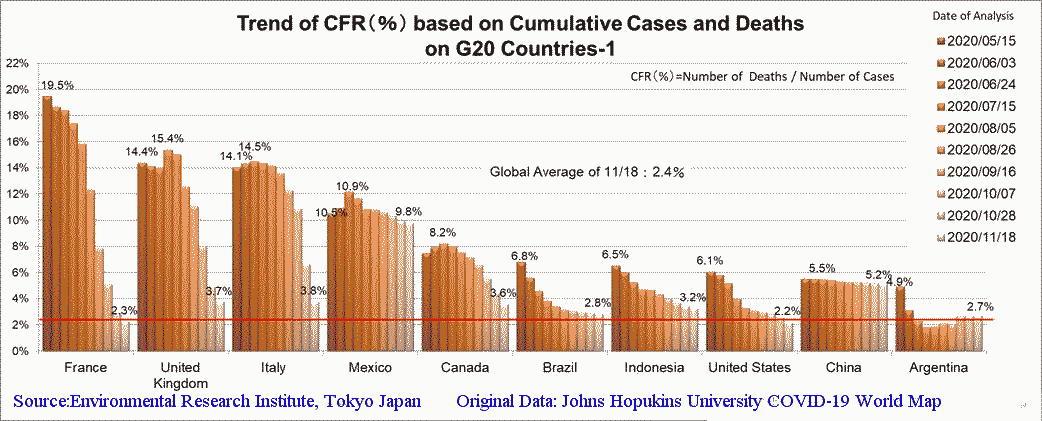
★10th Analysis : Trends of CFR(%) by G20 members based on cumulative data-1
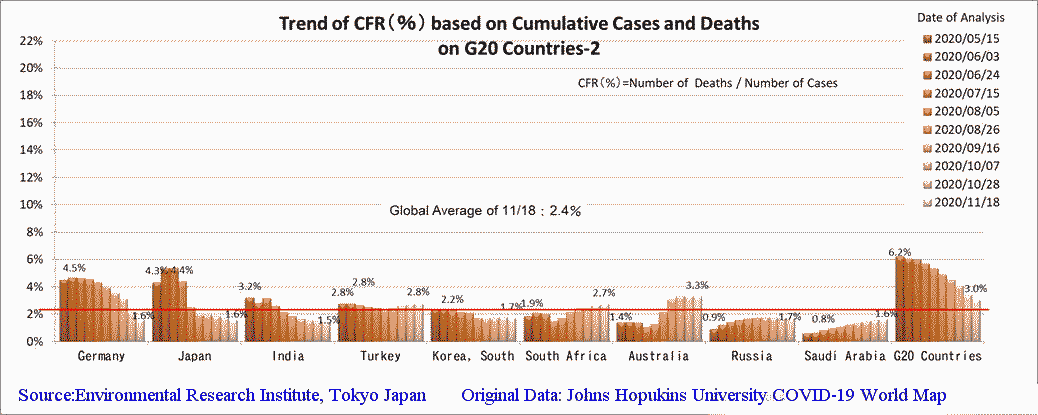
★10th Analysis : Trends of CFR(%) by G20 members based on cumulative data-2
(4)-2 Trends in CFR(%) with a 3-week time lag : G20
・ Considering the time lag, the average CFR of G20 countries has dropped
from 6.7% to 2.50% in the last six months, but has been flat since late
August.
・ In many countries, it had decreased to around 1% in the first half of
October, but from late October to mid-November, it showed an upward trend
in France, Mexico, Canada, Germany, Turkey, Saudi Arabia, etc. Looking
at the changes from the end of October, France has 1.3⇒1.9, Mexico has
6.3⇒8.6, Canada is 1.4⇒2.1, Germany is 1.3⇒1.9, Turkey is 4.2⇒4.5, Japan
is 1.2⇒1.5, and Saudi Arabia is 3.9⇒4.3, all of which are slightly becoming
higher.
・ Mexico increased by more than 2 points to 8.6% in 3 weeks, and turned
to a large increase. The number of cases increased slowly from mid-February,
and on August 1, less than 10,000 people were newly infected each day.
Since then, it has been declining slowly, but since September it has been
flat to slightly increasing, and on October 5, the highest number of infections
to date, more than 28,000, was confirmed. The death toll has remained high
since it exceeded 1,000/day on June 3, and has remained between 500 - 900/day.
However, on October 5, more than 28,000 cases were confirmed daily, and
the death toll reached an abnormal peak of more than 2,800. The cause is
unknown.
・ In Japan, the number of people who were infected in May and died by the
middle of June was high at 8.5%, but has remained at around 1.5% since
then. It seems that the high rate of infection and death of the elderly
in the spring time have declined after that.
・ Fatality rates have not improved significantly in countries such as Indonesia,
Argentina, Turkey, South Africa and Saudi Arabia. These countries should
continue to be watched as the number of deaths remains uncontrolled as
the number of infected cases increases.
・ In Australia, the death toll was well controlled around March and relatively
low. A second wave of deaths then peaked in August as the season moved
into winter, but gradually tended to decline as spring and summer progressed.
・ In countries where the number of deaths in the second wave in the autumn
exceeded those in the first wave in the spring, it is concerned that the
number of deaths will rise in the future, as the country's medical care
is not able to keep up with the rapid increase of infection.
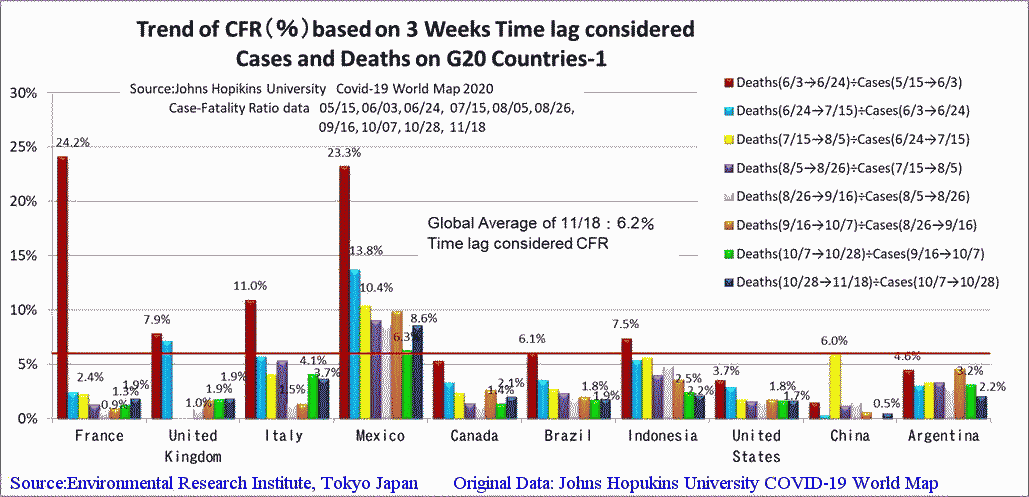
★6th Analysis: Trends of CFR(%) by G20 members with 3-week time lag -1
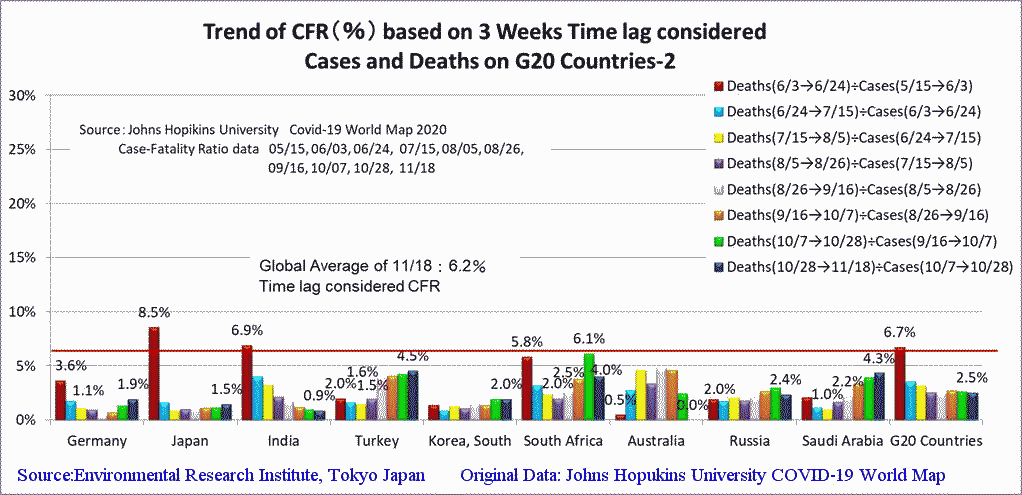
★6th Analysis: Trends of CFR(%) by G20 members with 3-week time lag -2
Below is a graph showing the daily changes in the number of cases and deaths
in major countries of G20.(Sources are JHU, Covid-19 World Map)
Numerical values are November 18, 2020, when JHU data is acquired, graphs
are November 20, 2020, 9:26 am JST
 
★South Korea Infected Cases: 26,146 ⇒ 29,311 Deaths: 461 ⇒ 469 (changes
from 10/28 last time to 11/18 this time)
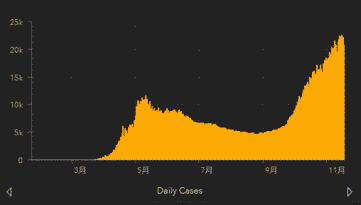 
★Russia Infected cases: 1,537,142 ⇒ 1,954,912 Deaths: 26,409 ⇒ 33,619
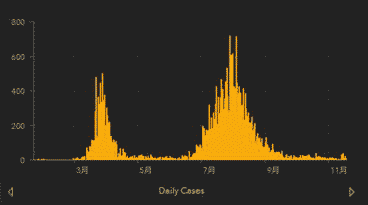 
★Australia Infected cases: 27,553 ⇒ 27,771 Deaths: 907 ⇒ 907 (zero during
this period)
--
(5) Case-fatality rate (%) by Country of EU members
(5) -1 Trends of CFR(%) by region and economic zone based on the cumulative
number of deaths and cases, 10th Analysis
Note:This is the 10th report of the CFR survey without time lag, which
has been continued since the 1st survey.
・The average CFR of EU countries fell by 5 points from 6.7% to 1.7% in
about half a year. In each country, the trend remained high until the first
half of June.
・Across the EU, the end of summer and the start of autumn and winter have
seen an another outbreak of infection spread, with another lockdown spreading
anxiety in society.
・ CFR has decreased relatively due to the increase in the number of cases,
but it may increase in the future as the number of deaths is increasing
again.
・ In mid-November, six months after the start of the survey, Belgium, Italy,
Sweden, Spain, Ireland are above the world average. On the whole, the fatality
rate in the Eastern European countries (former socialist countries) has
remained low. However, the peak of the disease has come late in Bulgaria
and Hungary, and there is a risk of a rise in CFR in the future.
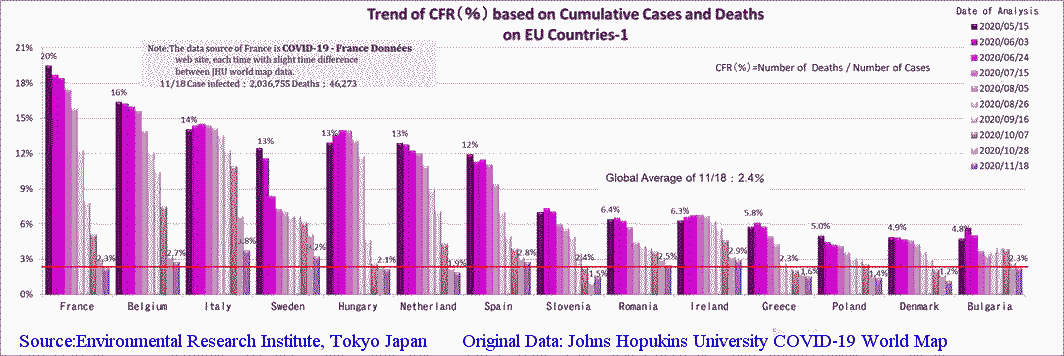
★10th Analysis: Trends of CFR(%) by EU countries based on cumulative data-1
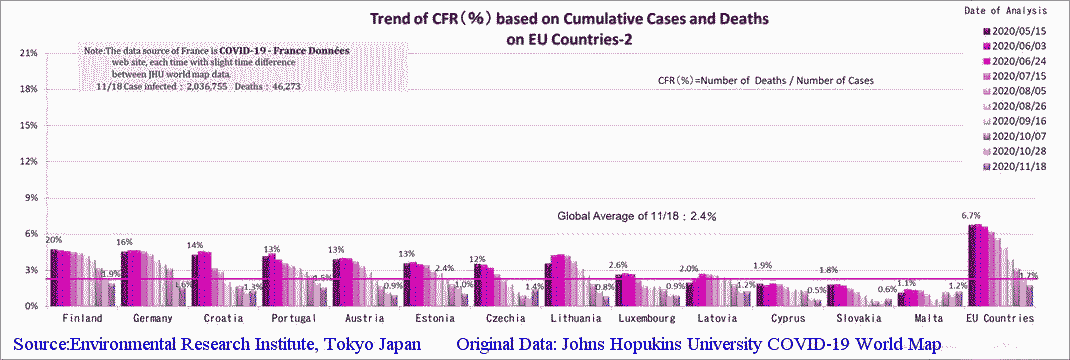
★10th Analysis: Trends of CFR(%) by EU countries based on cumulative data-2
(5)-2 Trends of CFR(%) with a 3-week time lag : EU
・ The case fatality rate of EU countries was as high as 5.8% by mid-June,
but dropped to 1.3% by mid-September, considering the time lag. However,
it continued to increase after that, rising to 2.4% in mid-November.
・ In general, there are many countries that bottomed out in August (the
lowest value) and then slowly rose into the autumn. This is most notable
in Hungary, Spain, Greece, Portugal and Austria.
・ Sweden was very low at 0.6% in mid-September, but increased more than
10 times to 7% in early September. There was concern after that, but it
dropped to 0.4% again in late October. In November, it started to rise
again and reached 1.6%. The peak number of deaths exceeded 100 per day
in mid-April, but on November 18, the number of deaths approached 100 again,
indicating the seriousness of the second wave.
・ Entering to November, the CFRs of considering time lag in Hungary, Greece,
and Bulgaria have reached a high value of over 5%. There is concern that
the CFR will rise in the future due to the rapid increase in the number
of deaths since the beginning of November.
・ In Croatia and the Czech Republic, the number of deaths has increased
sharply in November, so CFR is expected to continue to rise.
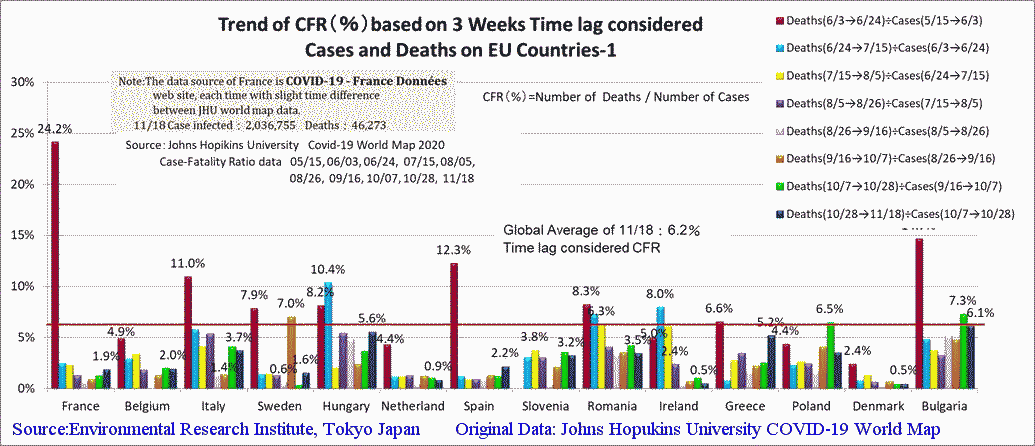
★6th Analysis: Trends of CFR(%) by EU countries with 3-week time lag -1
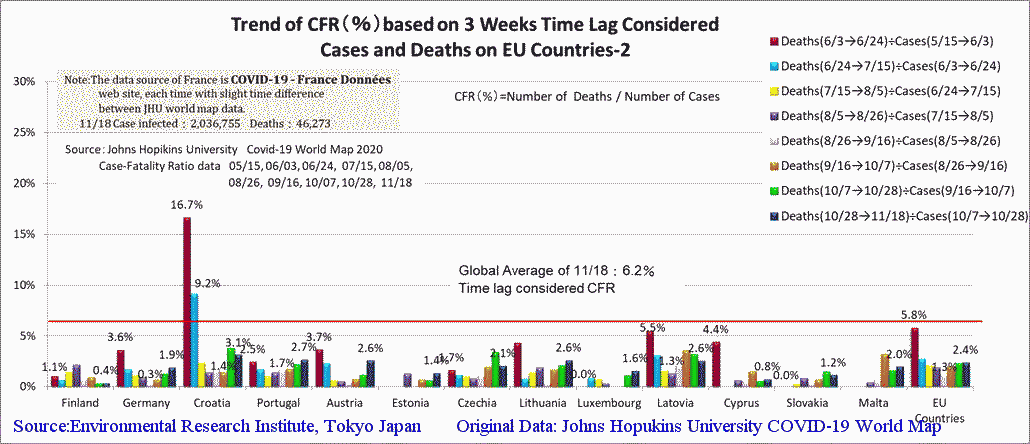
★6th Analysis: Trends of CFR(%) by EU countries with 3-week time lag -2
Below is a graph showing the daily changes in the number of cases and
deaths in major countries. (Sources are JHU, Covid-19 World Map)
Numerical values are at the time of JHU data acquisition on
November 18, 2020. Graph is at 9:26 am JST on November 20, 2020.
 
★Sweden Infected cases: 115,785 ⇒ 192,493 Deaths: 5,918 ⇒ 6,225
(Changes from 10/28 last time to 11/18 this time)
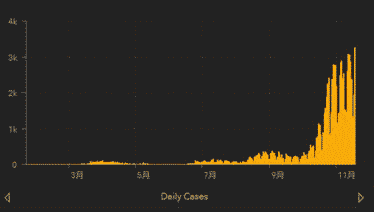 
★Croatia Infected cases: 38,621 ⇒ 87,464 Deaths: 470 ⇒ 1,113
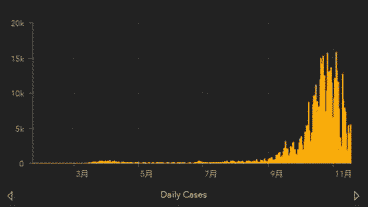 
★Czech Infected cases: 284,033 ⇒ 469,769 Deaths: 2,547 ⇒ 6,558
--
(6) Case-fatality rate (CFR) by countries of Ireland, Switzerland and New
Zealand (countries not included in G7, G20, and EU)
(6)-1 Trends in CFR(%) by region and economic zone based on the cumulative
number of deaths and cases, 10th Analysis
Note:This is the 10th report of the CFR survey without time lag, which
has been continued since the 1st survey.
Here, we are looking at three countries, Ireland, Switzerland, and New
Zealand (abbreviated as ISN), which are not included in each of the above
economic zones.
・ The average CFR of the cumulative number of cases and the number of deaths
in these three countries has decreased by about 2.8 points from 4.6% to
1.8% in about 6 months.
・ Ireland and Switzerland have been declining, but Ireland is still above
the world average.
・ Switzerland fell to 1.3% in November, well below the average. In Switzerland,
the number of cases was low at the peak of the first wave in spring and
March, and it was able to maintain a low level steadily in the summer after
that, but the number of cases increased sharply after October, and on November
2nd. More than 20,000 cases are confirmed per day, and the momentum is
surpassing that of spring. In the first wave of April, the maximum number
of deaths was about 75 per day, but on November 16th, the number of deaths
approached 170, and the tension is increasing. It is necessary to pay attention
to the transition of CFR since the end of November.
・ New Zealand is stable at a low number by suppressing the spread of infection
from the early stages.
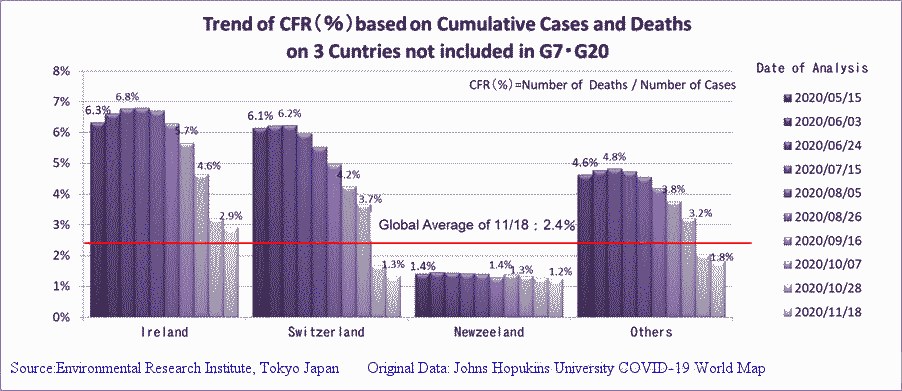
★10th Analysis: Trends of CFR(%) by 3 countries(ISN) based on cumulative
data
(6)-2 Trends in CFR(%) with a 3-week time lag : ISN
・ Looking at the CFR considering the time lag as of November 18, the averages
of the three countries continued to rise gradually from the end of summer
and changed from 0.5% to 0.9%.
・ Ireland saw a second wave of infection in October, but the death toll
was kept low, starting at 1.1% and has dropped to 0.5%.
・ On the other hand, in Switzerland, the number of deaths was higher in
the second wave, and the CFR increased three times from the previous time,
changing from 0.7% to 2.2%, pushing up the average of these three countries.
・ New Zealand has controlled the spread of the disease from the early stages
of spring and has remained at a low figure.
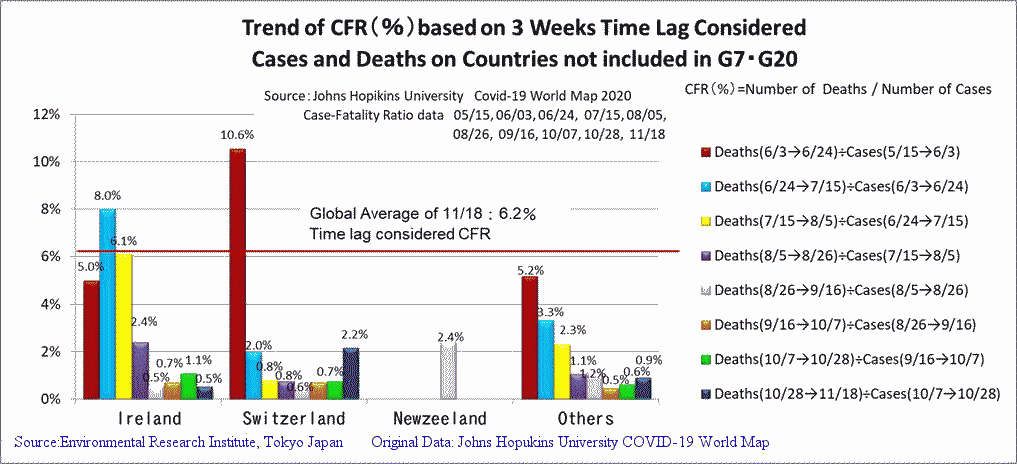
★6th Analysis: Trends of CFR(%) by ISN (countries other than G7 and G20)
with a 3-week time lag
Below is a graph showing the daily changes in the number of infected people
and the number of deaths in Switzerland.
(Sources are JHU, Covid-19 World Map) Numerical values are at the time
of JHU data acquisition on
November 18, 2020. Graph is at 9:26 am JST on November 20, 2020.
 
★Switzerland Infected cases: 127,042 ⇒ 274,534 Deaths: 2,147 ⇒ 3,664
(changes from 10/28 last time to 11/18 this time)
(7) Case-fatality rate (CFR) by country of BRICS members
(7)-1 Trends in CFR(%) by region and economic zone based on the cumulative
number of deaths and cases, 10th Analysis
Note:This is the 10th report of the CFR survey without time lag, which
has been continued since the 1st survey.
・ The average case fatality rate of BRICS countries based on the cumulative
data for the past 6 months has decreased by 1 point from 3.7% to 2.8%,
and has been flat since July.
・The US ranks first in the world in terms of the number of cases, followed
by India, Brazil and Russia, which previously ranked second to fourth,
but with France's surge, the order has changed with India in second place,
Brazil in third and Russia in fifth. However, the total number of cases
in India, Brazil and Russia has increased by 2 million in three weeks to
over 17 million, accounting for 30% of the world total.
・ In Brazil, the CFR has improved from 6.8% to 2.8%, but the spread of
infection that started in mid-March peaked in late July with 70,000 cases
a day. Since then, although it has continued to descend the mountain, the
number of cases per day has remained high, with 68,000 confirmed in late
September and 49,000 in mid-November, and the death toll around 1,000 per
day. The CFR has stopped falling, but it is hard to predict whether it
will make it down the mountain.
・ India, the total number of cases exceeded 9 million on November 19, making
it the second largest number of cases in the world. It peaked at 97,000
infected people a day in mid-September, and has been descending the mountain
since then, but from the end of October to mid-November, there are still
40,000 to 50,000 cases every day. Therefore, there is concern that the
CFR will rise in the future. The number of deaths is also declining in
parallel with the mountain of the cases, but from October to November,
about 500 deaths still occur every day.
・ The infection situation in South Africa has been declining gradually
since the first wave of the mountain was in mid-July. The number of cases
per day at the peak was about 14,000, and the number of deaths peaked from
late July to August, approaching a maximum of 600 people deaths per day.
Since then, it has gradually declined, but with 100-150 deaths confirmed
daily since October, the question is how far South Africa will be able
to contain the deaths from now on.
・ Russia's case fatality rate has been flat at 1.7% since August. The first
wave peaked in May with more than 10,000 cases a day, followed by more
than 200 deaths a day in June-July, but the first wave did not come down
the mountain and then began to rise again in the autumn, with the second
wave surpassing the first. The number of cases in mid-November exceeded
20,000 a day, and the number of deaths is approaching 500 a dat. Judging
from this situation, it is apparent that the experience of the first wave
has not been fully taken advantage of.
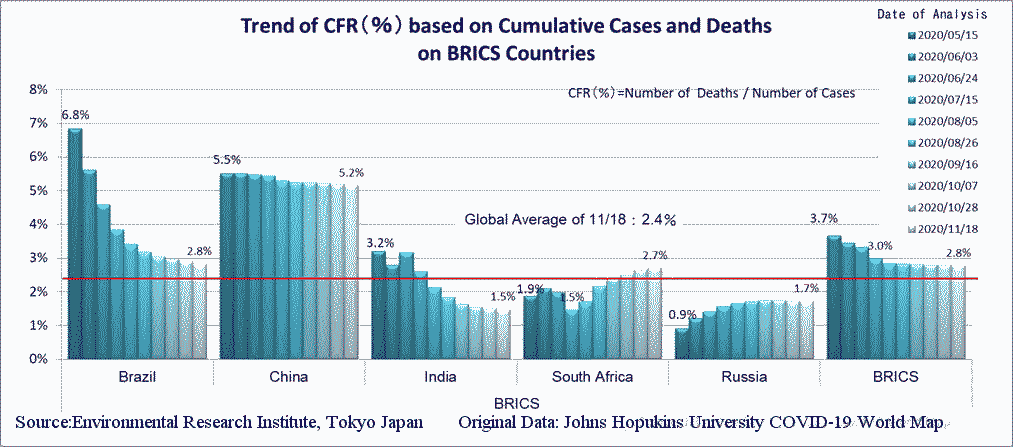
★10th Analysis: Trends of CFR(%) by Country of BRICS based on cumulative
data
(7)-2 Trends in CFR(%) with a 3-week time lag : BRICS
・ Considering the 3-week time lag, the average CFR of the BRICS countries
has fallen from 4.5% to 1.9% in the last six months.
・ In Brazil and India, the number of cases has continued to increase, and
the CFR has been declining relatively to the right, but in Brazil, there
has been no significant improvement since August.
・ On the other hand, in South Africa, the CFR has been on an upward trend
since August, and in October it was 6.1%, which was a severe situation
exceeding June. However, it fell again in mid-November, returning to 4.0%.
・ In Russia, it had been around 2.0% until summer, but it increased from
the end of August to 3.0% in late October, which was higher than June.
Although the CFR has fallen slightly in November, both infections and deaths
are now well above the first wave, and it is feared that the number of
infections and deaths during the upcoming holiday season will again push
up the CFR.
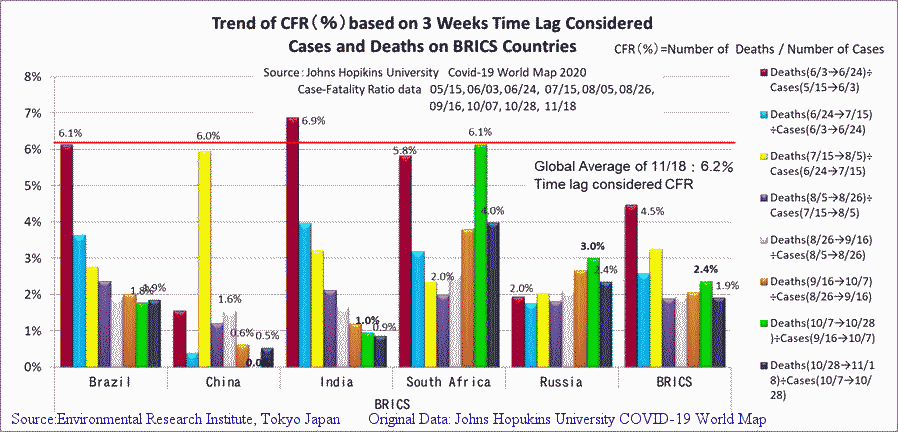
★6th Analysis: Trend of CFR(%) by country of BRICS with a 3-week time lag
Below is a graph showing the daily changes in the number of infected people
and the number of deaths in major countries. (Sources are JHU, Covid-19
World Map)
Numerical values are at the time of JHU data acquisition on November
18, 2020. Graph is at 9:26 am JST on November 20, 2020.
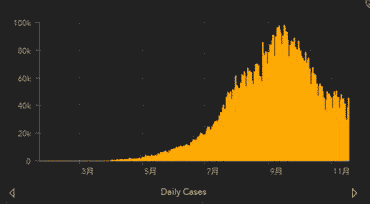 
★India Infected cases: 7,946,429 ⇒ 8,874,290 Deaths:119,502 ⇒ 130,519
(Changes from 10/28 last time to 11/18 this time)
 
★Brazil Infected cases: 5,439,641 ⇒ 5,911,758 Deaths: 157,946 ⇒ 166,699
 
★South Africa Infected cases: 717,851 ⇒ 754,256 Deaths: 19,053 ⇒ 20,432
(8) Case-fatality rate (CFR) by country in ASEAN members
(8)-1 Trends in CFR(%) by region and economic zone based on the cumulative
number of deaths and cases, 10th Analysis
Note: This is the 10th report of the CFR survey without time lag, which
has been continued since the 1st survey.
・ The average CFR(%) of ASEAN countries during this period has decreased
slightly from 2.1% to 1.4%, but has remained flat since mid-July.
・ In the Philippines, CFR had been steadily declining until the end of
August, but after that it started to rise again and remained at around
1.9%. The peak number of daily cases reached 6,700 in August, and the number
of deaths was expected to reach 100 a day. The peak death toll exceeded
250/day in mid-September. After that, it is slowly decreasing.
・ Indonesia has fallen to the right, down about 1/2 or 3.3 points in the
last 6 months. The number of cases has gradually increased since March,
and the number of cases per day has approached 5,000 since the beginning
of September, recording a late peak. Since then, the number of cases has
been trending downwards, but in November, more than 5,000 cases a day confirmed.
Thus, there are concerns that they will not be able to make it down the
mountain sufficiently. The number of deaths, which peaked at 220 in mid-September,
is also on the decline, but with around 100 deaths still being confirmed
daily, convergence has been slow to take place.
・ Myanmar(Burma) continued to decline for four months from May to September,
but in October it rose sharply to the level at the end of June and remained
flat at around 2.3%. From spring to August, the number of cases remained
in the single digits a day, but the infection began to spread from the
end of August, and on October 10, the number of cases
exceeded 2,000 a day. The death toll also peaked on October 11 with 48
deaths. It will be important to see if the downward trend continues in
the future.
・ Thailand and Brunei are flat at around 1-2%, and there is no major change.
・ Malaysia seems to be declining steadily when looking at the CFR. Although
the first wave of infection in spring was small, the second wave, which
began to spread in mid-September, was large. On November 6th the number
of cases to be close to 1,800, and the number of deaths was 12 a day, which
is higher than the first wave. It has been on a downward trend since mid-November,
but whether it starts to converge depends on whether it can be maintained
in the future.
・ Indochina Peninsula countries such as Cambodia, Laos, and Vietnam continued
to have zero deaths, but in August, deaths were confirmed in Vietnam, and
the case fatality rate increased, but it is decreasing slightly. In Vietnam,
infections began to be confirmed in mid-January, and the peak was that
45 people were confirmed daily in July, repeating mountains and valleys
several times. The death toll was concentrated between the end of July
and the beginning of September, bringing the total to 35. No deaths have
been confirmed since then.
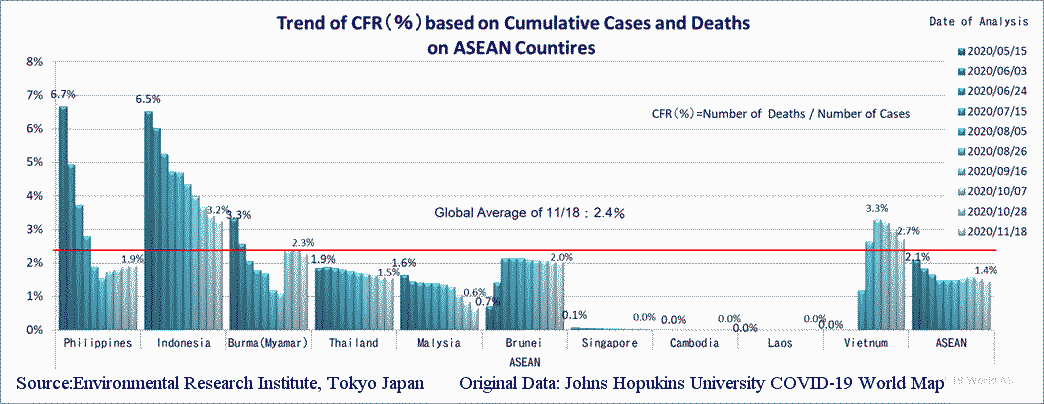
★10th Analysis: Trends of CFR(%) by ASEAN members based on cumulative data
(8)-2 Trends in CFR(%) with a 3-week time lag : ASEAN
・ In consideration of the time lag, in ASEAN countries, the CFR value fluctuated
significantly in the last 6 months, but it decreased to 0.7% in mid-November.
・ The reason for these fluctuations is that at the end of July, the first
deaths were confirmed in Vietnam, and in September, the death toll in Myanmar
rose sharply. This is likely to have led to a sharp rise in the CFR in
the ASEAN countries. However, the death toll in Vietnam is unchanged at
a maximum of 3 people a day and a cumulative total of 35 people.
・ Brunei, Singapore, Cambodia and Laos have lowered the CFR mean for this
group as very few deaths have been reported during these 6 months. The
total deaths of Brunei is 3, Singapore is 28, Laos and Cambodia are reported
as 0 deaths.
・ The ASEAN region tends to be much later in the spread of the disease
than Europe, the US and other regions, and therefore tends to take advantage
of a wide range of global experience and knowledge to keep the number of
deaths low. In addition to the climatic characteristics of hot and humid
weather, it has been suggested that the racial characteristics of Asians
may also play an advantageous role in the spread of the virus.

★6th Analysis: Trends of CFRs(%) by ASEAN countries with a 3-week time
lag
Below is a graph showing the daily changes in the number of cases and deaths
in major countries.
(Sources are JHU, Covid-19 World Map)
Numerical values are at the time of JHU data acquisition on November
18, 2020. Graph is at 9:26 am JST on November 20, 2020.
 
★Myanmar Infected cases: 47,666 ⇒ 71,730 people Deaths: 1,147 ⇒ 1,625 people
(Changes from 10/28 last time to 11/18 this time)
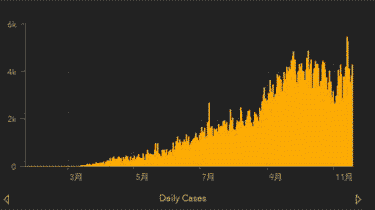 
★Indonesia Infected cases: 396,454 ⇒ 474,455 Deaths: 13,512 ⇒ 15,393
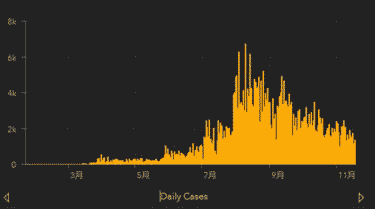 
★Philippines Infected cases: 373,144 ⇒ 410.718 Deaths: 7,053 ⇒ 7,862
(9) Case-fatality rate (CFR) by country in Former Socialist Countries
(9)-1 Trends in CFR(%) by region and economic zone based on the cumulative
number of deaths and cases, 10th Analysis
Note: This is the 10th report of the CFR survey without time lag, which
has been continued since the 1st survey.
・ The average CFR of this group, which includes Eastern European countries
plus Cuba and China, fell by 2.3 points from 4.0% to 1.7% in 6 months.
・ Although Hungary had a high number, the actual spread of infection began
in mid-September. Until then, the maximum number of cases was 30 to 40
per day, but it increased sharply after September, and reached its peak
on November 18, with nearly 8,000 cases a day. The number of deaths began
to increase in late August and exceeded 80 a day on November 11. What remains
to be seen is how quickly Hungary will be able to contain the first wave
of this late start to convergence.
・ In Eastern European countries, the number of cases and deaths were generally
low, and CFRs also remained low, but it must be closely watched for those
countries that have been on the rise since October.
・ As of November 18, the only country above the global average(2.4%), apart
from China, was Romania(2.5%), while Bulgaria was barely below at 2.3 percent.
・ In Bulgaria, the second wave since October has become the actual first
wave, and the number of cases has increased significantly from 42,701 to
106,598 between the previous time (Oct.28th) and this time. The total number
of deaths has also increased from 1,161 to 2,413 during the last 3 weeks.
・ Although the CFR is low, the two countries, Czech Republic and Slovakia,
have shown a slight increase since September. In the Czech Republic, the
number of cases and the number of deaths were low in the spring, but the
spread of the infection that started in the fall has become a substantial
first wave, and more than 15,000 cases are confirmed every day from the
end of October. The peak number of deaths per day is approaching 300 on
November 10. If the increasing trend continues in the future, there is
a concern that the CFR may become even higher. Currently, the number of
cases is 488,000 and the number of deaths is over 7,000.
・ Slovakia, a neighboring country, shows almost the same tendency as the
Czech Republic. At present, the number of cases is over 93,000 and the
number of deaths is about 600, which is less than that of the Czech Republic,
but the pattern of infection spread is similar. It should be noted that
if people come and go between the two countries frequently, it may increase
in the future.
・ Azerbaijan and Armenia may have been in a ceasefire, but they are rising
slightly.
・ In general, in the Eastern European countries the number of cases and
the number of deaths are kept low compared to the Western European countries
where the spread of infection preceded. It is hoped that the experiences
of the preceding Western European countries will be shared within the EU
members. However, since there are also economic disparities among the Eastern
European countries, and there are fears that the CFR will rise as a result
of the increase in deaths if it expands further.
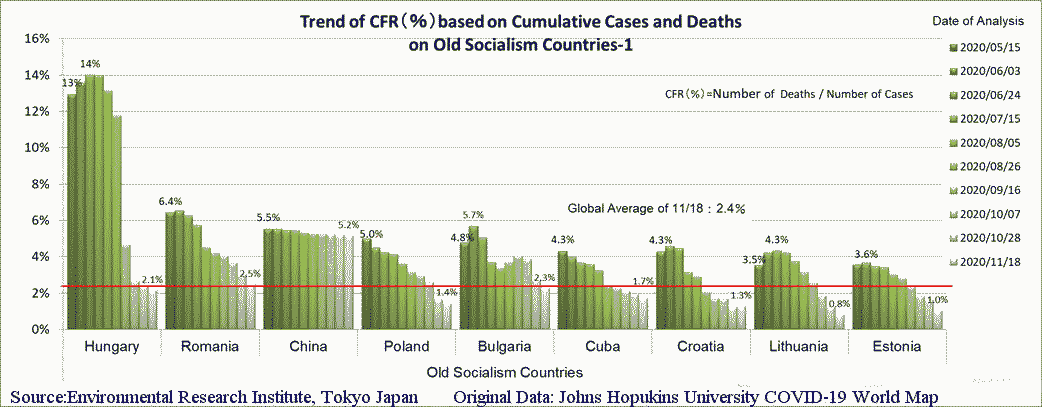
★10th Analysis: Trends of CFR(%) by Former Socialist Countries based on
cumulative data-1
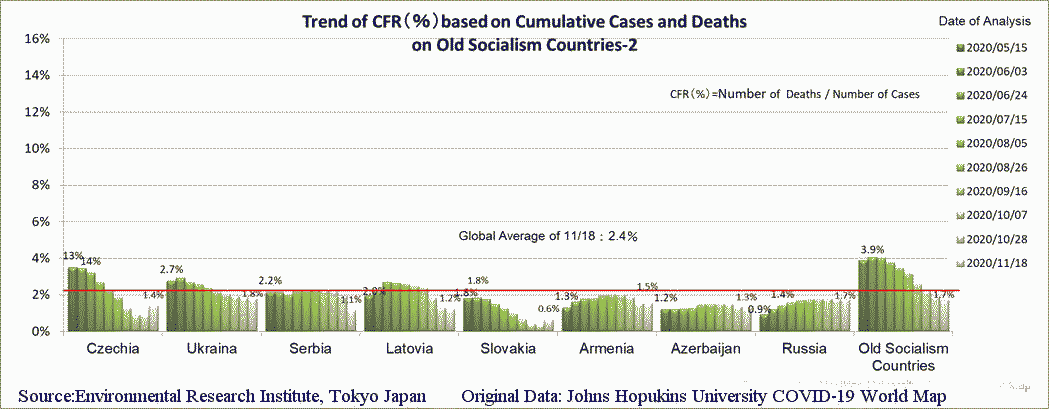
★10th Analysis: Trends of CFR(%) by Former Socialist Countries based on
cumulative data-2
(9)-2 Trends in CFR(%) with a 3-week time lag : Former Socialist Countries
・ As of November 18, the average CFR of the group with a 3-week time lag,
improved slightly from the end of October to 2.7%.
・ Hungary, Lithuania, Estonia, and Serbia rose in mid-November, but this
time the average in Africa rose tremendously to 6.2%, so the other areas'
average is generally below. This is due to the later peak period of infection
in Eastern European countries compared to Western European countries.
・ Armenia and Azerbaijan have improved from the last time, but will continue
to watch out, depending on whether the peace is maintained.
・ The biggest change during this period was in Croatia, which fell from
17% to 1.4% in the summer, but started to rise again in the fall.
・ Outside of Eastern Europe, it is noteworthy that China is again at 0.5%
CFR. Specifically, in China, the number of cases in mid-October was 550,
while the number of deaths three weeks later, from late October to mid-November,
was as few as three, and the CFR was as low as 0.5%, indicating that the
infection was under control.
・ Cuba rose slightly in the summer, but remained low again in the fall.
Currently, the total number of cases is about 7,800 and the number of deaths
is about 130.
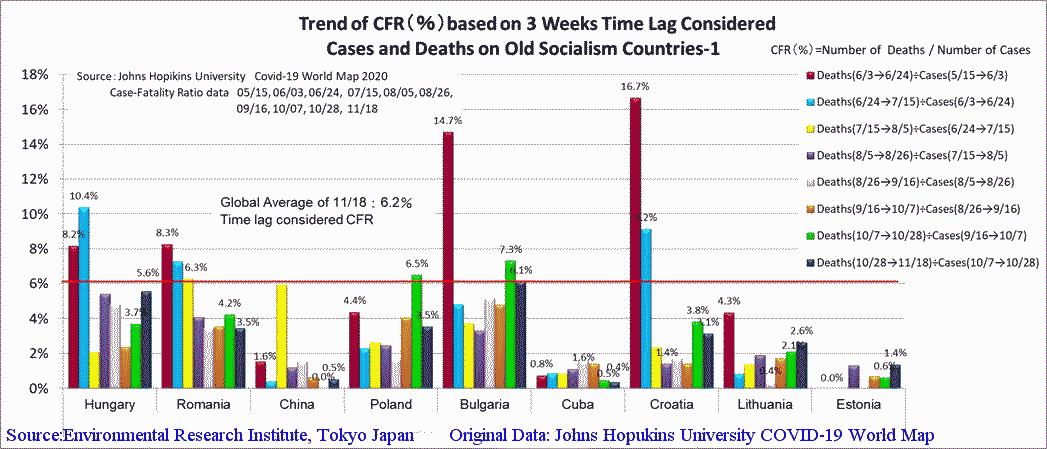
★6th Analysis: Trends of CFRs(%) by Former Socialist Countries with 3-week
time lag -1
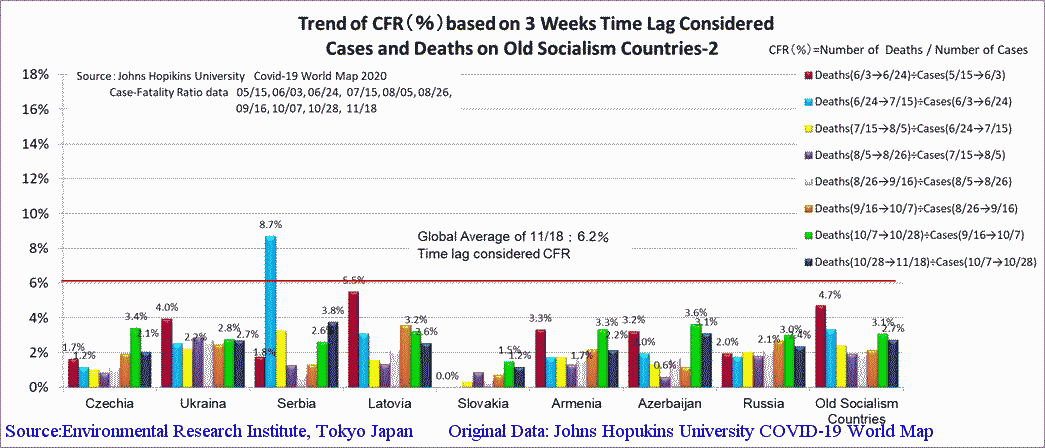
★6th Analysis: Trends of CFRs(%) by Former Socialist Countries with 3-week
time lag -2
Below is a graph showing the daily changes in the number of cases and deaths
in major countries.
(Sources are JHU, Covid-19 World Map)
Numerical values are at the time of JHU data acquisition on November
18, 2020. Graph is at 9:26 am JST on November 20, 2020.
Eastern Europe such as Hungary and Bulgaria has increased rapidly since
October. In addition, the number of cases in both Azerbaijan and Armenia
has increased by about 30,000 in three weeks perhaps due to the influence
of the war.
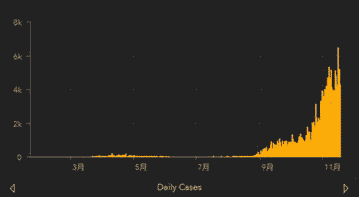 
★Hungary Infected cases: 63,642 ⇒ 152,659 Deaths: 1,535 ⇒ 3,281
(changes from 10/28 last time to 11/18 this time)
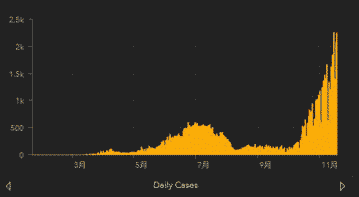 
★Azerbaijan Infected cases: 51,149 ⇒ 79,158 Deaths: 688 ⇒ 1,005
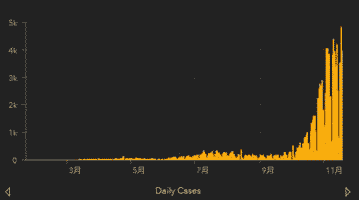 
★Bulgaria Infected cases: 42,701 ⇒ 106,598 Deaths: 1,161 ⇒ 2,413
--
(10) Case-fatality rate (CFR) by the Scandinavia/Nordic countries
(10)-1 Trends in CFR(%) by region and economic zone based on the cumulative
number of deaths and cases, 10th Analysis
Note:This is the 10th report of the CFR survey without time lag, which
has been continued since the 1st survey.
・ In the Scandinavian and Nordic countries, the CFR(%) based on cumulative
data has fallen by approximately 3.5 points from 5.1% to 1.6% in the last
6 months.
・ In this group, Sweden, which has gone its own unique approach of taking
no special measures for the pandemic, has seen a marked improvement, dropping
about 10 points from 13% to 3.2%, while the CFR is the highest in the group
at 3.2%, well above the global average of 2.6%.
・ Other countries have been stable.
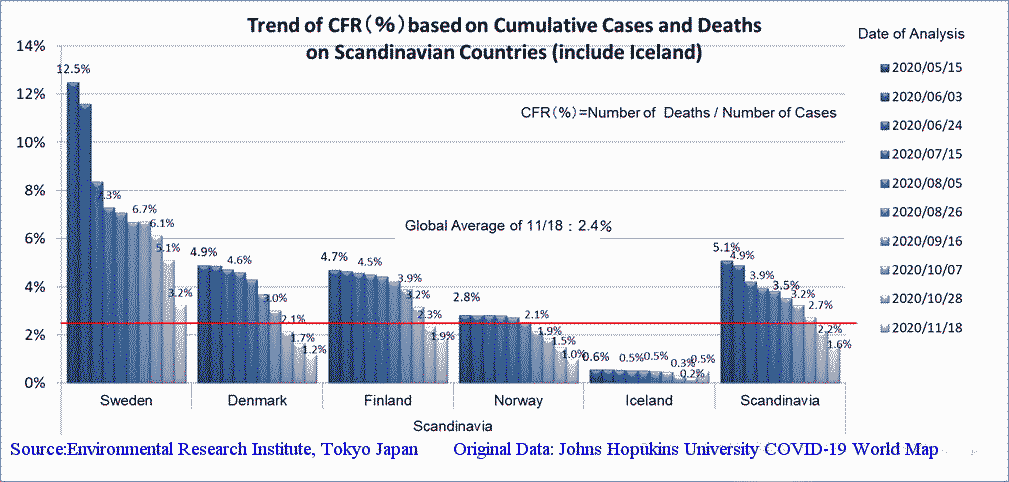
★10th Analysis: Trends of CFR(%) by Scandinavia/Nordic countries based
on cumulative data
(10)-2 Trends in CFR(%) with a 3-week time lag : Scandinavia/Nordic
・ As of September, the average CFR of this group with a 3-week time lag
decreased significantly from 3.1% to 0.4%, but in October it started to
increase again due to the large increase in Sweden, reaching 1.8%. However,
it dropped sharply in late October to 0.3%, returning to the level at the
end of August, but started to rise again in November. The increase in October
is likely to be due to the effects of the second wave in Norway and Iceland,
along with a rise in Sweden.
・ Despite being at a very low of 0.6% until mid-September, Sweden has been
rising and falling since then, and nearly quadrupling to 1.6% on 18 November
from the previous 0.4%. From spring to July, the maximum number of cases
was about 1,700 a day, but the rapid spread of infection began at the end
of September after the summer vacation, and in November, more than 15,000
cases a day has been confirmed. On the other hand, the number of deaths
was about 115 per day at the peak of spring in mid-April, but in the second
wave, nearly 100 deaths have already occurred on November 18, and there
are concerns about the future.
・ Denmark, Finland and Norway all rose in October, but started to decline
in late October. Neighboring Norway, which is adjacent to Sweden, has shown
a similar trend, so whether or not the numbers will continue to fall will
depend on future measures.
・ In Iceland, no one has died since April 20th, but in October, the number
of deaths was confirmed again, and there appears two mountains. As a result,
CFR rose from 0.1% to 0.9%.

★6th Analysis: Trends of CFRs(%) by Scandinavia/Nordic countries with 3-week
time lag
Below is a graph showing the daily changes in the number of infected people
and the number of deaths in major countries. (Sources are JHU, Covid-19
World Map)
Numerical values are at the time of JHU data acquisition on November
18, 2020. Graph is at 9:26 am on November 20, 2020 JST.
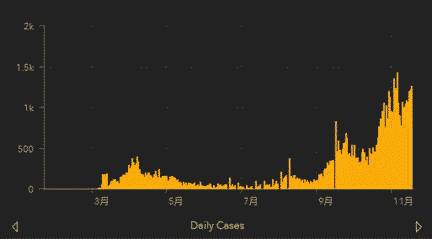 
★Denmark Infected cases: 42,668 ⇒ 65,067 Deaths: 709 ⇒ 768
(Changes from 10/28 last time to 11/18 this time)
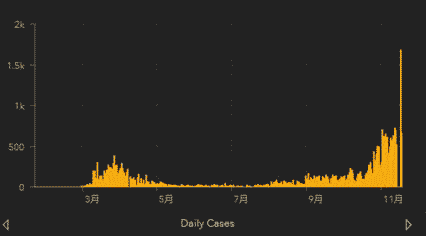 
★Norwegian infected cases: 18,666 ⇒ 30,114 deaths: 280 ⇒ 298
(11) Case-fatality rate (CFR) in Central and South American countries
(11)-1 Trends in CFR(%) by region and economic zone based on the cumulative
number of deaths and cases, 10th Analysis
Note: This is the 10th report of the CFR survey without time lag, which
has been continued since the 1st survey.
・ The average CFR value based on the cumulative value of this group has
remained almost unchanged during this period, ranging from 3.7% to 3.1%.
・ In Mexico, CFR continues to be high at around 10% even in late November.
The cumulative number of infected people exceeded 1 million on November
14, ranking 11th in the world. The cumulative death toll surpassed 100,000
on November 19, confirming the high fatality rate.
・ As of November 18, Brazil, the CFRs of Honduras, Argentina, Bolivia,
Colombia, Peru, Guatemala, El Salvador, and Chile have exceeded the world
average of 2.4%, in addition to Mexico. You can see the difficult situation
in Central and South America.
・ Cuba, the Dominican Republic, Panama, Uruguay, Paraguay, and Costa Rica
all fell below the average, all of which remained unchanged from the previous
survey and have not improved, but Cuba and Uruguay have been on a downward
trend.
・ In this area, the spread of infection in mountainous and scattered rural
areas will be difficult to deal with, so caution is needed.
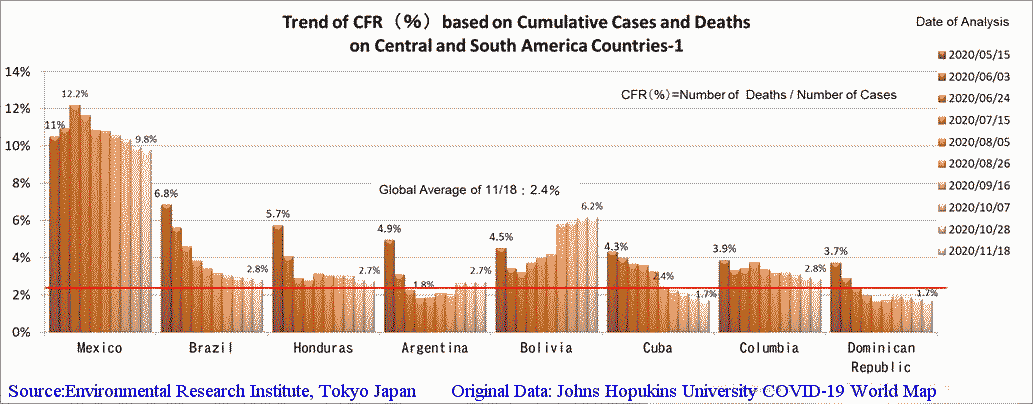
★10th Analysis : Trends of CFR(%) by Central and South American countries
based on cumulative data-1
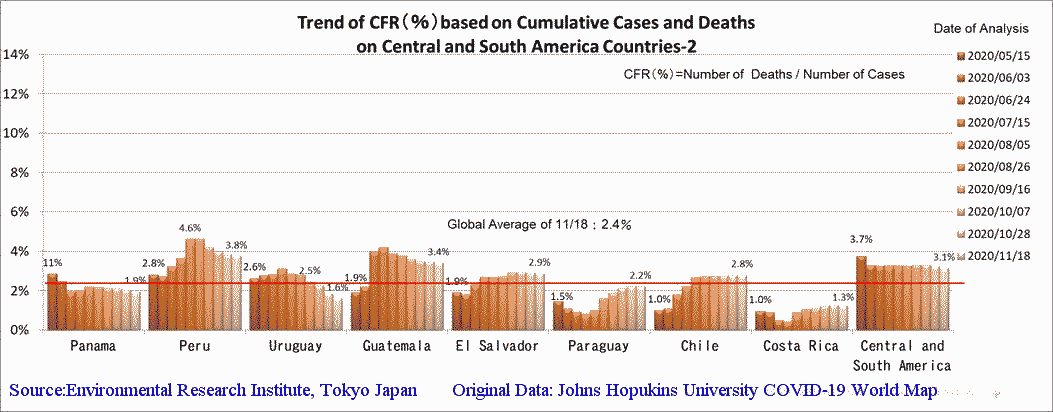
★10th Analysis : Trends of CFR(%) by Central and South American countries
based on cumulative data-2
(11)-2 Trends in CFR(%) with a 3-week time lag : Central and South America
・ Considering the time lag, the CFRs of this group decreased by 3.1 points
from 5.6%, which is 2.5 points down during these 6 months and remained
at the same level as the previous time.
・ Considering a 3-week time lag, the CFR in Mexico in June was extremely
high at 23%, but dropped to 8% in early September and once again rose to
nearly 10% in early October. After that, it declined again, but in November
it rose to nearly 9% again, showing no signs of improvement. More than
28,000 people were infected on October 5, and more than 2,700 people died
on the same day.
・ In Argentina, the spread of infection, which began in spring, peaked
in mid-October, infecting 18,000 people a day, and on October 14, prior
to that, the total number exceeded 1 million. In terms of the number of
cases, it is the 8th largest in the world. The death toll began to increase
in mid-July and continued for more than 100 days. Since mid-October, the
number of cases has begun to decline, but the question is how far the death
toll can be contained. As a matter of fact, 3,351 people died on October
1.
・ In Bolivia, which is located in the north of Argentina, the peak of infection
overlaps with the dry season from July to August. More than 2,000 cases
per day were reported at the peak, but have been declining since mid-August.
At present, the mountain of the first wave is large and has not reached
the second wave. Considering the time lag, CFR rose to 10% in September,
surpassing Mexico, but then dropped to 4%. However, it rose again from
mid-October to mid-November and remained in the 5% range. The number of
deaths has been around 50 a day for a long time, but on September 7, the
deaths counted 1,656 a day. The cause was unknown, but the value was abnormal.
・ Guatemala has been infected with 1,000 people a day for a long time,
but there are signs that it will gradually decrease from the latter half
of September. The peak was confirmed in mid-July with just under 5,000
cases a day. The number of deaths peaked at 60 a day in the latter half
of July, but it has been declining gradually since then, but more than
60 deaths a day have been confirmed again in November. As Guatemala shares
a border with Mexico, both may have been affected each other by the spread
of the disease.
・ Chile reached its peak of infection in early June, and the number of
cases per day exceeded 12,000. After that, the number of cases per day
dropped to around 2,000 at the end of August, but it is still reported
at around 1,800 a day as being the number remains flat. The cumulative
number of deaths has reached 15,000, and on July 17, more than 1,000
deaths were reported.
・ Costa Rica has reached its peak of infection since the beginning of September,
and it has been reported that 2,000 people are infected each day. The number
of deaths peaked in September, killing nearly 40 people a day, but has
been declining since then. Unfortunately however, the latest data shows
that Costa Rica hits highest daily cases of 2,877 in
November 23 and is again facing serious situation.
・ El Salvador reached its peak of infection from mid-July to mid-August,
and about 450 people were infected a day, but after that, it fell once
and was hit by the second wave again from September. The number is reported
to be nearly twice that of the first wave. The cumulative number of deaths
has exceeded 1,000, but the peak was in August, and the
number of deaths was currently around 15 per day.
In general, the Latin American region as a whole, the peak times differ
from country to country, so it tends to be difficult to coordinate and
converge as a whole.
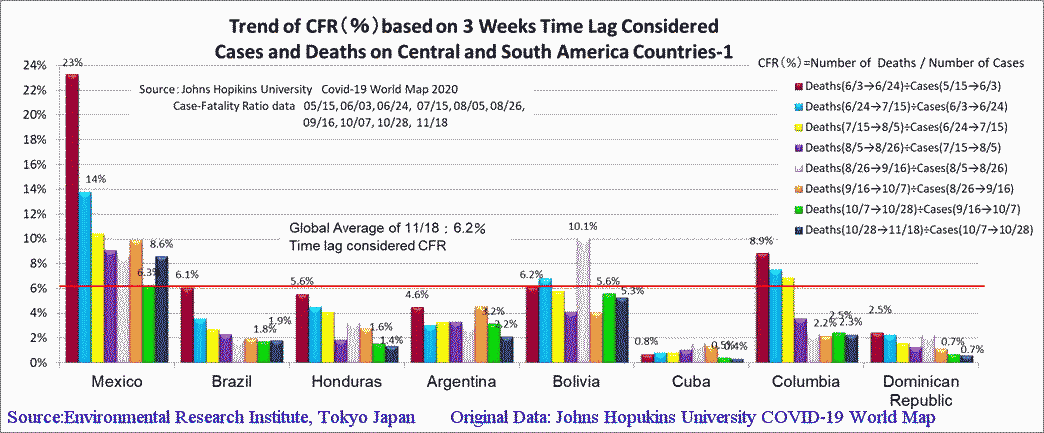
★6th Analysis: Trend of CFR(%) in Central and South American countries
with a 3-week time lag -1
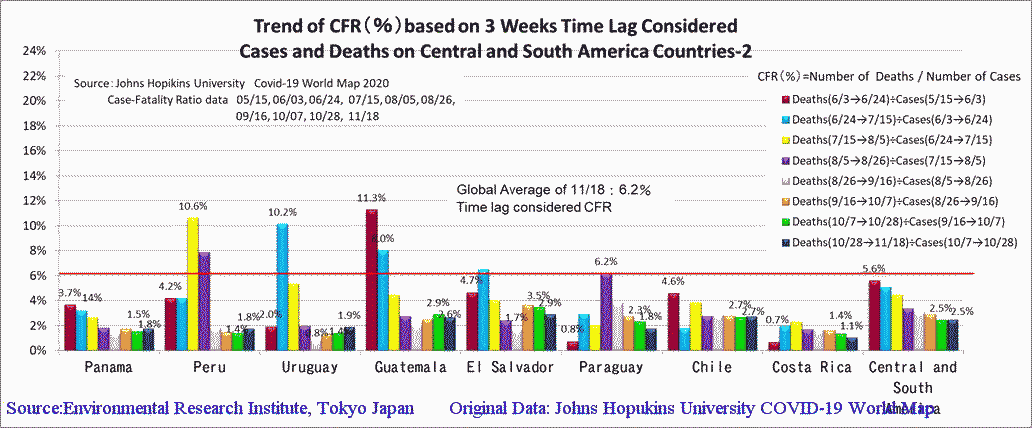
★6th Analysis: Trend of CFR(%) in Central and South American countries
with a 3-week time lag -2
Below is a graph showing the daily changes in the number of cases and deaths
in major countries.
(Sources are JHU, Covid-19 World Map)
Numerical values are at the time of JHU data acquisition on November
18, 2020. Graph is at 9:26 am JST on November 20, 2020. (Changes from 10/28
last time to 11/18 this time)
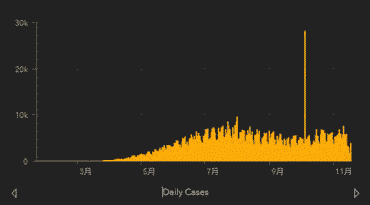 
★Mexico Infected cases: 901,268 ⇒ 1,011,153 Deaths: 89,814 ⇒ 99,026
There were more than 28,000 infections on October 5, and more than 2,700
deaths on the same day.
 
★Argentina Infected cases: 1,116,609 ⇒ 1,329,005 Deaths: 29,730 ⇒ 36,106
Deaths 3,351 on October 1st
 
★Colombia Infected cases: 1,033,218 ⇒ 1,211,128 Deaths: 30,565 ⇒ 34,381
--
(12) Case-fatality rate (CFR) by country in Africa
(12)-1 Trends in CFR(%) by region and economic zone based on the cumulative
number of deaths and cases, 10th Analysis
Note:This is the 10th report of the CFR survey without time lag, which
has been continued since the 1st survey.
・ The average CFR of African countries for the past 6 months has dropped
from 4.1% in mid-May to 2.6%, but has been flat since late June.
・ In November, many countries were below the world average of 2.4%, while
in Africa, Zimbabwe, Algeria, Mali, Egypt, Sudan, Tunisia, Somalia, Tanzania
and South Africa were above the average. Among them, Sudan (7.8%), Egypt
(5.8%), Tanzania (4.1%) and Mali (3.5%) have the highest CFRs.
・ Two countries, Sudan and Tunisia, have risen sharply in November. In
Sudan (15,047 cases and 1,175 deaths), the CFR has risen significantly
since late October, as 278 people died on 8 November.
・ Tunisia (81,723 cases and 2,445 deaths) has been hit by a rapid spread
since August, and more than 5,000 cases have been reported on October 17.
The number of deaths has continued to increase since mid-September as the
infection spreads, and on November 7, 217 people died in one day. As a
result, CFR, which was low in early September, has started to rise again.
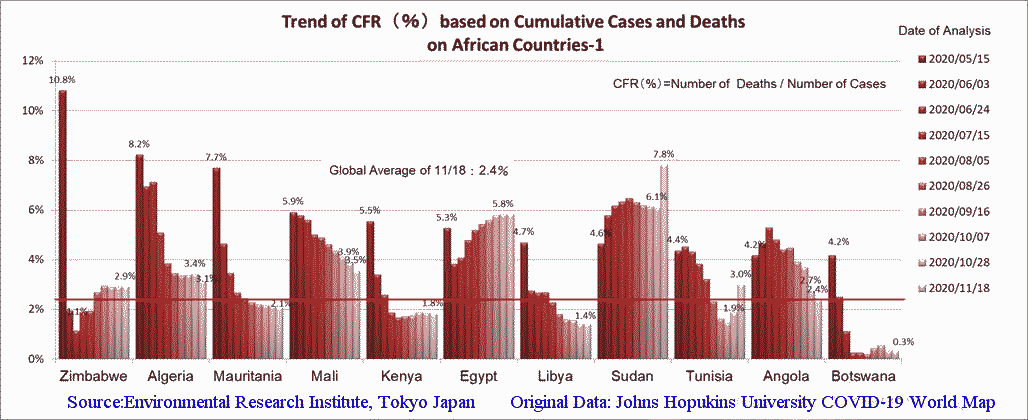
★10th Analysis : Trends of CFR(%) by African countries based on cumulative
data-1
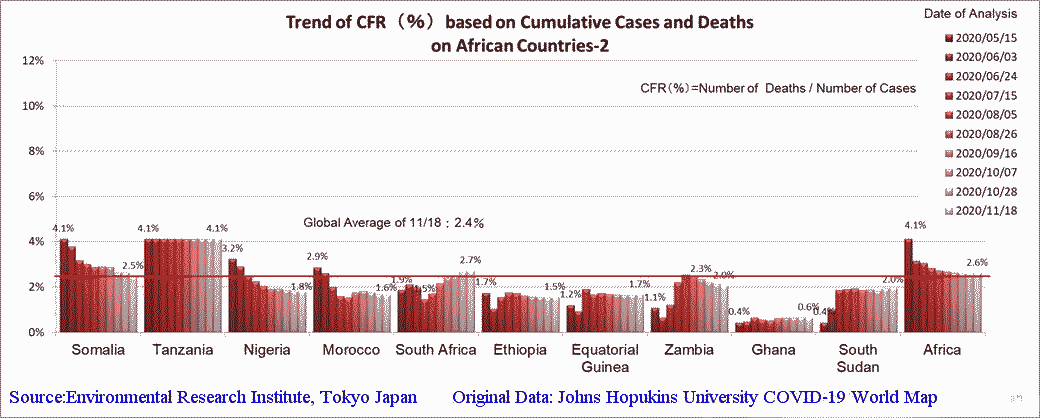
★10th Analysis : Trends of CFR(%) by African countries based on cumulative
data-2
(12)-2 Trends in CFR(%) with a 3-week time lag : Africa
・ During this six-month period, the average CFR for this group had fallen
from 5.1% to 2.7% by the end of October, although up and down along the
way when a 3-week time lag is taken into account. However, in November,
an increase in the number of deaths in Sudan led to a significant increase
in the global average to 6.2% and the African average to 21%.
・ In Sudan (15,047 cases and 1,175 deaths) there was a significant increase
in the CFR, taking into account the time lag. This was due to the high
number of deaths (338) between late October and 18 November, ompared to
94 cases in the three-week period of 8-28 October, resulting in a CFR of
360%.
・ South Africa is followed by Morocco (about 300,000 cases and 5,000 deaths),
Egypt (about 110,000 cases and 6,500 deaths) and Ethiopia (about 100,000
cases and 1,600 deaths), all of which contain densely populated cities
and have close ties to the European countries.
・ The CFRs of Egypt (8.7%) and Sudan (360%) have exceeded the world average
of 6.2% in mid-November.
・ CFRs in Zimbabwe, Algeria, Mauritania, Tunisia, Somalia and Nigeria have
been on the rise since late October.
・ Algeria was hit by the first wave in March, followed by a second wave
in August and a third wave in November, which gradually peaked higher.
Looking at the number of cases and the number of deaths, in the first wave
from April to May, the maximum number of infected people was 200 per day
and the number of deaths was 30 on April 19. However in July, the second
wave in the middle of the July, the number of cases increased to 800/day
at the peak, and the number of deaths remained around 15/day for several
months after the first wave. And in the third wave in mid-November, the
number of cases reached 1,000/day, and the number of deaths reached 20/day.
・ CFR of Somalia (4,400 cases and 100 deaths) was 1.4% in May, but increased
to 5.5% in early September. After that, it decreased once, but increased
again from the end of September to November.
・ In South Sudan (3,000 cases and 60 deaths), the figures have fluctuated
up and down, falling to 1.2% at the start of October, rising to 4.2% in
November and then falling again to 1.9%. As for the cases, the peak of
the first wave was about 140 a day in mid-July, but it decreased after
that, and in November, 70 to 80 cases a day, although it did not
reach 100 cases a day in the second wave. The number of deaths peaked in
July with three deaths a day for about several continuous days. There have
been only four deaths per day since the beginning of November.
・ Although there is still uncertainty in the data for African countries,
the spread of the disease in dispersed settlements, along with its spread
in densely populated areas, will also increase the fatality rate, so it
is necessary to control the spread of the disease as much as possible.
・ It is also possible that overland travel within the continent has spread
the infection.
・ Libya, Kenya, and Algeria have almost the same number of infected people,
about 70,000 to 75,000, and deaths from 1,000 to 2,000. Since Libya and
Algeria share a border with each other, traffic between the two countries
is likely to affect both.
・ Since the peak of infection in Libya is at the end of October (1,700
cases/day), the number of deaths will continue to increase, and CFR may
rise accordingly. The peak death toll continued from September to October,
with 20 to 25 deaths per day.

★6th Analysis: Trends of CFR(%) by African countries with 3-week time lag -1

★6th Analysis: Trends of CFR(%) by African countries with 3-week time lag-2
Below is a graph showing the daily changes in the number of infected cases
and deaths in major countries.
(Sources are JHU, Covid-19 World Map)
Numerical values are at the time of JHU data acquisition on November
18, 2020. Graph is at 9:26 am JST on November 20, 2020.
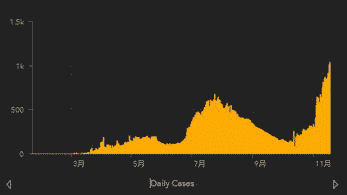 
★Algeria Infected cases: 56,706 ⇒ 69,591 deaths: 1,931 ⇒ 2,186
(changes from 10/28 last time to 11/18 this time)
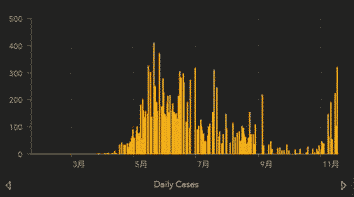 
★Sudan Infected cases: 13,747 ⇒ 15,047 Deaths: 837 ⇒ 1,175
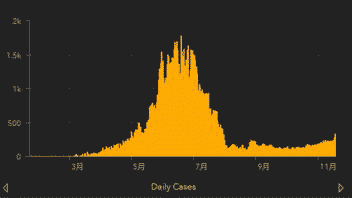 
★Egypt Infected cases: 106,877 ⇒ 111,284 Deaths: 6,222 ⇒ 6,481
(13) Case-fatality rate (CFR) by country in Middle East
(13) -1 Trends in CFR(%) by region and economic zone based on the cumulative
number of deaths and cases, 10th Analysis
Note:This is the 10th report of the CFR survey without time lag, which
has been continued since the 1st survey.
・ The average CFR based on cumulative data from Middle Eastern countries
rose slightly from 3.2% to 3.7% during the six months from May to November,
but has remained broadly flat. This may be due to the extremely high CFR
in Yemen, as well as the fact that CFRs in Syria, Iran and other countries
with political unrest have not declined.
・ CFRs of Lebanon, Israel, Jordan, Kuwait, UAE, Qatar are gradually declining
and kept low.
・ Turkey has remained flat at 2.8-2.6%.
・ Iran is the most infected among the Middle East countries, with 830,000
cases and more than 40,000 deaths. The number of cases was leveled during
the summer after the first wave in March, but increased sharply in the
fall, and four times as many cases as in the spring have been confirmed.
In terms of the number of deaths, it is clear that CFRs may continue to
increase in the future as the number of deaths has gradually increased
from the first wave in March, the second wave in July and the third wave
in November.
・ Iran is followed by Iraq with 500,000 cases, Turkey with 400,000 cases,
and Saudi Arabia and Israel with around 300,000 cases, but the patterns
of infection spread are different for each. The Gulf areas such as Jordan,
Oman, Kuwait, Qatar, Lebanon and the UAE all have a cumulative total of
120,000 to 160,000 cases.
・ Although Lebanon has been kept at a low level since spring, the number
of cases has been increasing since July, reaching a peak of over 2,000/day
in November. Social turmoil and economic exhaustion after the accident
of factory explosion may have affected.
・ Excluding Yemen, the CFRs of Syria and Iran are higher than the rest
of the countries, above 5 per cent, while the rest of the countries have
remained relatively low. They can be divided into Iraq, Lebanon, UAE and
Kuwait, which have shown a gradual downward trend, Turkey, Jordan, Saudi
Arabia and Oman, which have shown a slight upward trend since around July-August,
and Bahrain and Qatar, which have seen little change.
・ Bahrain has the lowest number of cases in the region, and the cumulative
total has not reached 10,000. The death toll is about 330. However, Qatar
has maintained a low cumulative death toll of 235 while the number of cases
is high at over 130,000. This is due to the fact that the number of cases
in Qatar peaked in May and has remained around 200 since July. Therefore,
the cumulative CFR is at its lowest, at 0.2%.
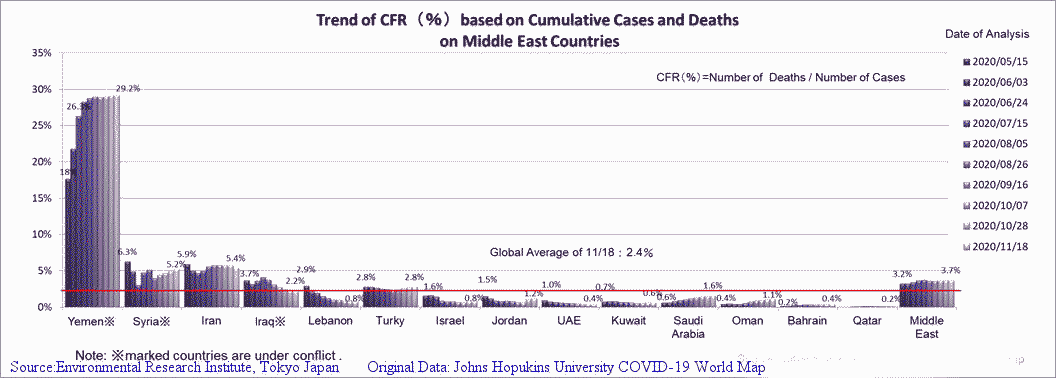
★10th Analysis : Trends of CFR(%) by Middle East countries based on cumulative
data-1
(13)-2 Trends in CFR(%) with a 3-week time lag : Middle East
・ When considering the time lag, the average value of CFRs for the entire
Middle East region decreased from 6.8% to 3.8% at the end of October, but
rose again in November and returned to 6.8%, the same level as in May.
・ The CFR in Yemen fell from 55% to 11% in early October in June, but it
rose again to 19.4% in late October and further to 62% in November.
・ Both Syria and Iran have high values of around 8-9% even in November.
Iran is being hit by the third wave in terms of the number of deaths.
・ Although other countries are kept low, the CFR of Jordan rose sharply
in early October but fell slightly in late October. Looking specifically
at Jordan, the number of cases and deaths remained low until early September,
but it rose upward from mid-September, peaked in November. It has risen
to 8,000 cases a day, and the number of deaths is approaching 100 a day
in early November. It will be closely watched to see if the downward trend
continues after the peak in late November.
・ Although most of the Middle Eastern countries except politically uncertain
areas have been kept low, it is noteworthy that Turkey and Saudi Arabia
have reached high levels even in November. In Turkey, both the number of
cases and the number of deaths have risen since November. In Saudi Arabia,
the first wave of large mountains arrives from June to July. Since then,
the number of cases has remained between 400 and 500 per day and has not
fallen sufficiently. Under such circumstances, although the number of deaths
has started to decline from a peak of 57 on 4 July, it has not dropped
to the spring level of 10 deaths per day, so that the CFR may continue
to rise as the number of deaths remains at 20 per day for over a month.
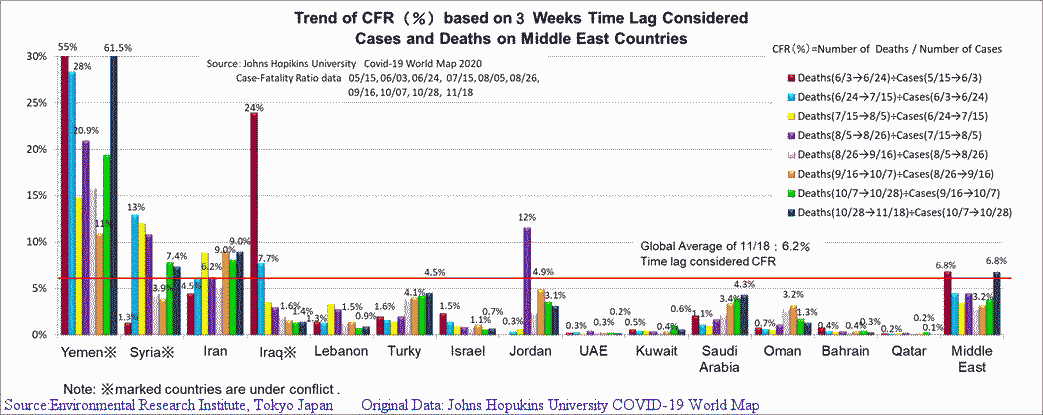
★6th Analysis: Trends of CFR(%) by Middle East Countries with 3-week time
lag
Below is a graph showing the daily changes in the number of cases and deaths
in major countries.
(Sources are JHU, Covid-19 World Map)
Numerical values are at the time of JHU data acquisition on November
18, 2020. Graph is at 9:26 am JST on November 20, 2020.
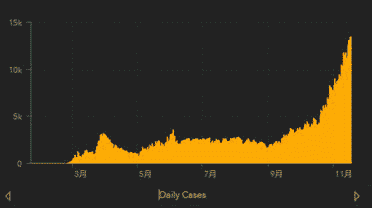 
★Iran Infected cases: 581,824 ⇒ 788,473 Deaths: 33,299 ⇒ 42,461 (Changes
from 10/28 last time to 11/18 this time)
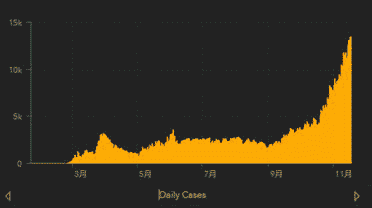 
★Lebanon Infected cases: 73,995 ⇒ 107,953 deaths: 590 ⇒ 839
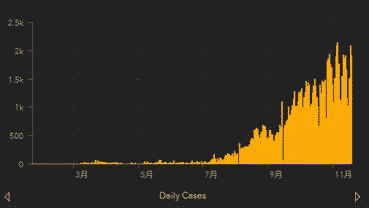 
★Turkey Infected cases: 366,208 ⇒ 421,413 Deaths: 9,950 ⇒ 11,704
--END--
|